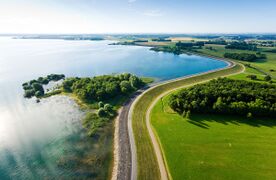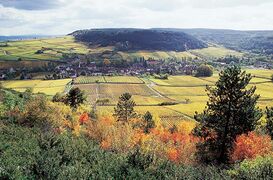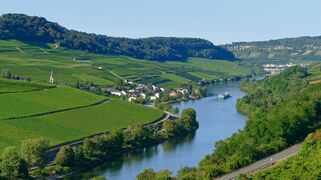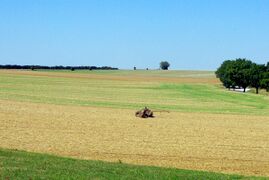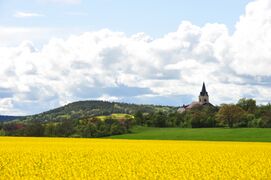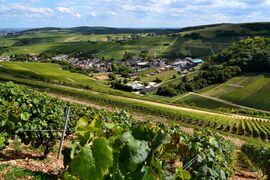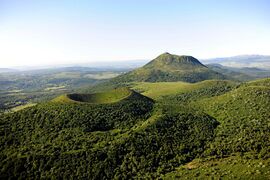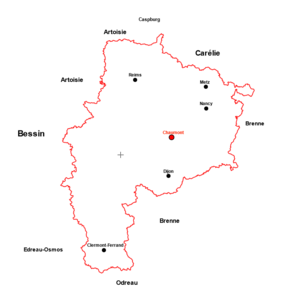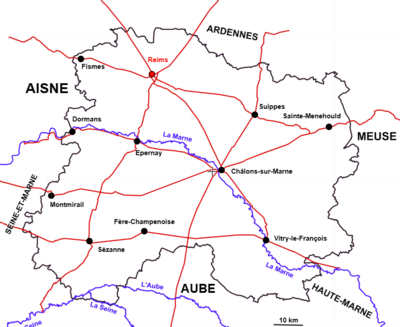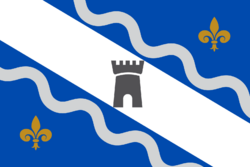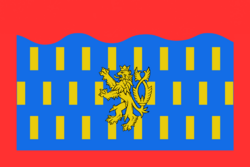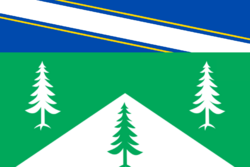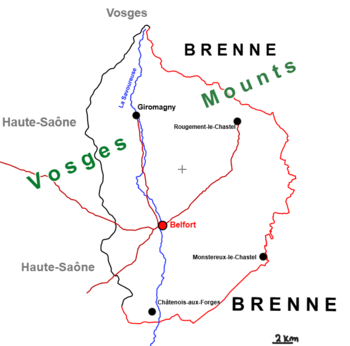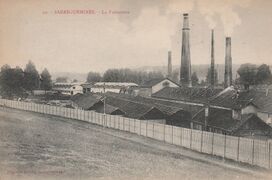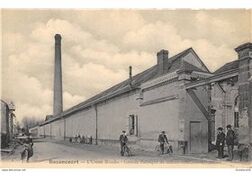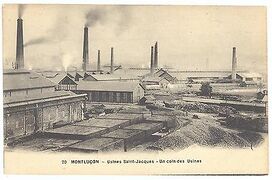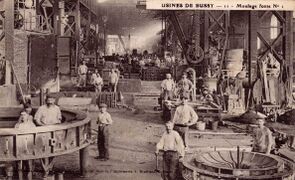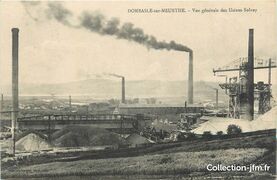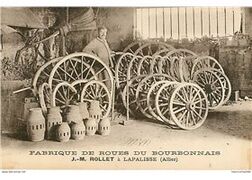Voisey: Difference between revisions
m (→Regions and Departments: Map of Belfort) |
|||
| (143 intermediate revisions by the same user not shown) | |||
| Line 1: | Line 1: | ||
[[Category:Countries]] | [[Category:Countries]] | ||
{{WIP}} | |||
{{Infobox country | {{Infobox country | ||
| Line 7: | Line 7: | ||
|image_flag = Drapeau Lille.jpg | |image_flag = Drapeau Lille.jpg | ||
|national_motto = <br/>{{native phrase|fr|"Liberté – Fidelité – Justice"|italics=off}}<br/>{{small|"Liberty – Fidelity – Justice"}} | |national_motto = <br/>{{native phrase|fr|"Liberté – Fidelité – Justice"|italics=off}}<br/>{{small|"Liberty – Fidelity – Justice"}} | ||
|national_anthem = {{wp|Le Chant des Partisans|Voisey la victorieuse}}<br>[[File:MediaPlayer.png|link=https://www.youtube.com/watch?v=g3D9M5-4tWg|200px]] | |||
|official_languages = {{hlist |[[French language|French]]}} | |official_languages = {{hlist |[[French language|French]]}} | ||
|ethnic_groups = | |ethnic_groups = | ||
{{unbulleted list | {{unbulleted list | ||
| {{nowrap| | | {{nowrap|31% [https://fr.wikipedia.org/wiki/Champagne-Ardenne Champenois]}} | ||
| | | 19% [https://fr.wikipedia.org/wiki/Lorraine Lorrain] | ||
| | | 17% [https://fr.wikipedia.org/wiki/Bourgogne_(ancienne_r%C3%A9gion_administrative) Bourguignon] | ||
| 6% [ | | 10% [https://fr.wikipedia.org/wiki/Pays_de_Nied Francique] et [https://fr.wikipedia.org/wiki/Alsace Alsacien] | ||
| 3.5% [[ | | 7% [https://fr.wikipedia.org/wiki/Auvergne Auvergnats] | ||
| 0.5% [ | | 6% [https://fr.wikipedia.org/wiki/Franche-Comt%C3%A9 Franc-Comtois] | ||
| 4% [https://fr.wikipedia.org/wiki/Picardie_(ancienne_r%C3%A9gion_administrative) Picard] | |||
| 3% [https://fr.wikipedia.org/wiki/Orl%C3%A9anais Orléanais] | |||
| 1.5% [https://fr.wikipedia.org/wiki/Berry Berrichon] | |||
| 1.5% [https://fr.wikipedia.org/wiki/Duch%C3%A9_de_Bourbon Bourbonnais] | |||
| <0,5% [https://fr.wikipedia.org/wiki/Ardenne Ardennais] | |||
| <O,5% [https://fr.wikipedia.org/wiki/Brie_(r%C3%A9gion) Briard] | |||
}} | }} | ||
|demonym = Voiseyien, Voiseyienne | |demonym = Voiseyien, Voiseyienne | ||
| Line 24: | Line 31: | ||
|leader_name1 = [[Daniel Marangé]] | |leader_name1 = [[Daniel Marangé]] | ||
|leader_title2 = [[Prime Minister of Voisey|Prime Minister]] | |leader_title2 = [[Prime Minister of Voisey|Prime Minister]] | ||
|leader_name2 = [[Raymond | |leader_name2 = [[Raymond Barthélemy]] | ||
|legislature = [[National Assembly (Voisey)|National Assembly]] | |legislature = [[National Assembly (Voisey)|National Assembly]] | ||
||area_km2 = | ||area_km2 = 117287 | ||
|percent_water = 0.8% | |percent_water = 0.8% | ||
|population_estimate_year = 2021 | |population_estimate_year = 2021 | ||
|population_estimate = | |population_estimate = {{increase}} 8 452 177 | ||
|GDP_nominal = $ | |GDP_nominal = {{increase}} $303 144 880 600 | ||
|GDP_nominal_year = 2021 | |GDP_nominal_year = 2021 | ||
|GDP_nominal_per_capita = $ | |GDP_nominal_per_capita = {{increase}} $35 865 | ||
|Gini_change = decrease<!--decrease--> | |Gini_change = decrease<!--decrease--> | ||
|Gini = | |Gini = 31 <!--number only--> | ||
|HDI_year = 2021 | |HDI_year = 2021 | ||
|HDI_change = increase <!--decrease--> | |HDI_change = increase <!--decrease--> | ||
|HDI = 0. | |HDI = 0.885 <!--number only--> | ||
|HDI_rank = | |HDI_rank = 6th | ||
|currency = [[ | |currency = [[Franc]] | ||
|currency_code = FV | |currency_code = FV | ||
|time_zone = UTC+0 | |time_zone = UTC+0 | ||
| Line 46: | Line 53: | ||
|cctld = .vy | |cctld = .vy | ||
}} | }} | ||
== | |||
Voisey (/vwa.ze/) is a [https://fr.wikipedia.org/wiki/%C3%89tat_souverain sovereign state] located on the continent of [[WIP|Primeria]]. Voisey is a unitary constitutional republic with a [https://fr.wikipedia.org/wiki/R%C3%A9gime_semi-pr%C3%A9sidentiel semi-presidential regime]. The motto has always been "Liberty, Fidelity, Justice". The national colours of the flag are blue, white and red with two black lions holding a coat of arms with a white [https://fr.wikipedia.org/wiki/Lys lily], a sign of peace but of strength. Above the lily sits a giant fortress, a sign of resistance. The capital is [[Chaumont]]. The official language of Voisey is French. Dialects such as [https://fr.wikipedia.org/wiki/Champenois Pavois], [https://fr.wikipedia.org/wiki/Champenois Bassignot],[https://fr.wikipedia.org/wiki/Champenois Sennonais], [https://fr.wikipedia.org/wiki/Champenois Troyen], [https://fr.wikipedia.org/wiki/Champenois Argonnais],[https://fr.wikipedia.org/wiki/Champenois Rémois], [https://fr.wikipedia.org/wiki/Champenois Vallage], [https://fr.wikipedia.org/wiki/Champenois Langrois ](which is a very rarely spoken dialect), [https://fr.wikipedia.org/wiki/Vosgien Spinalien], [https://fr.wikipedia.org/wiki/Vosgien Déodatien], [https://fr.wikipedia.org/wiki/Gaumais Gaumais], [https://fr.wikipedia.org/wiki/Lorrain Longovicien], [https://fr.wikipedia.org/wiki/Lorrain Nancéien],[https://fr.wikipedia.org/wiki/Lorrain Messin], [https://fr.wikipedia.org/wiki/Franc-comtois_(langue) Franc-comtois], and [https://fr.wikipedia.org/wiki/Francien Francien] are considered secondary languages and are spoken by about 71% of the population. The official currency is the Franc. Voisey has an important geopolitical role in the world, with an extensive network of embassies and consulates in all countries of the continent. Voisey is also the fifth largest nuclear power on the continent on a par with [[Artoisia|Artoisie]]. Voisey's has been repeatedly ranked in 1934, 1969, 1975, 1984-85, 2008, 2012 and 2020 as the world's number one Soft Power Rate thanks to its broad diplomatic reach, cultural richness and the strong international relations skills of its presidents. Voisey is the third largest economy in the world with a nominal GDP of 303.1 billion $US in 2021. With an unemployment rate of 2.2% (fourth quarter 2021), it has a "very high" standard of living (6th in the HDI ranking in 2021). Voisey is a world leader in the metal, food, automotive, nuclear and agricultural sectors. Voisey's is one of the largest countries in [[Primeria]]. The culture of Voisey is very old and supported by its citizens, who are very conservative and proud of their traditions. Voisey is a member of several global and regional organisations such as [[WEMO|WEMO]] (World Economic and Military Organisation) OMEM in French, [[IHO|IHO]] (International Health Organisation) OIS in French. Voisey is also part of the [[International Free Trade Zone|international free trade zone]] (white zone), the economic alliance of the Entente and the Paris Pact, aimed at helping nations in difficulty and, among other things, preventing a recurrence of the [[Great War (Primeria)|Great War]] (1969-1985). Voisey is part of the [[BVB]] (Bessin-Voisey-Brenne) since its creation in 1903. | |||
{{TOC limit|2|}} | |||
=Geography= | |||
<gallery mode="packed" caption="Landscapes of Voisey"> | |||
File:Foret Retz.jpg|Retz Forest in Aisne | |||
File:Lac du Der.jpg|Lac du Der in North Haute-Marne is a refuge for many birds such as migrating herons and storks. | |||
File:Foret du Corgebin.jpg|Corgebin Forest in Chaumont area | |||
File:Forêt d'Arc-en-Barrois en Haute-Marne.JPG|Arc en Barrois forest in Haute-Marne | |||
File:Prise de vue CO.jpg| Vineyards in the Côte d'Or | |||
File:Prise de vue A.jpg| View of the Meuse river at Monthermé in the Ardennes | |||
File:Prise de vue MEM.jpg| View of the Moselle in Meurthe et Moselle (region) | |||
File:Prise de vue S et M.jpg| Landscape in Seine et Marne around the town of Provins | |||
File:Prise de vue HM52.jpg|Landscape of central Haute-Marne | |||
File:Image Cher.jpg| Landscape of Cher in Western Voisey | |||
File:Chaine PDM.jpg| Landscape of Puy-de-Dôme with its mountains | |||
</gallery> | |||
===Location, borders and area=== | ===Location, borders and area=== | ||
Voisey is located in the | |||
Voisey is located in the north-east of the [[Primeria]] continent. The neighbouring countries are : [[Bessin]] to the southwest, [[Artoisia|Artoisie]] to the west, [[Brenne]] to the east, [[Carélie]] to the north and Edreau-Osmos to the south. Voisey doesn't have a coastline but it has an island: [[Archipel-Sainte-Louise]], wich is in the east. Voisey is one of the largest countries in Primeria with an area of 117,287 km2 . The borders with the neighbouring countries are characterised by small rivers, hedges or different types of fields. Stone markers mark the separation every kilometers. However, there are customs posts on the main roads. During the [[Great War (Primeria)|Great War]], the borders were guarded by the army. | |||
[[File:Carte de Voisey - voisins.png|thumbnail|center|A map of Voisey and its neighbours]] | |||
===Geology, topography and hydrography=== | ===Geology, topography and hydrography=== | ||
Voisey is a relatively mountainous country. The highest peak is [[Haut de Baissey]] at | |||
Voisey is a relatively mountainous country. The highest peak is [[Haut de Baissey]] at 1465 m, wich is a bit higherthan the [[Puys-de-Dôme]] volcanoes which rise to 1438m. The lowest point is the [[Jouvelle]] plain which is 310m above sea level. | |||
[[The Vosges massif]] to the east is also a high point in the area. These mountainous formations were formed during prehistoric times. | [[The Vosges massif]] to the east is also a high point in the area. These mountainous formations were formed during prehistoric times. | ||
The soils of Voisey are of sedimentary origin from the West and the ancient crystalline massif of the Vosges. | The soils of Voisey are of sedimentary origin from the West and the ancient crystalline massif of the Vosges. | ||
Several rivers | Several major rivers flow through Voisey, such as the [[Suize]], which flows into the sea, the [[Marne]], the [[Meuse]], the [[Meurthe]], the [[Saône]], the [[Aube]], the [[Seine]] (which does not originate in Voisey), the [[Allier]] (in the south), the [[Cher]], the [[Yonne]], the [[Loire]], the [[Aisne]], which originates in Sommaisne and flows into the larger [[Oise]], and the [[Aisne]], which ends at Amifontaine in [[Artoisia|Artoisie]]. | ||
===Climate=== | ===Climate=== | ||
Voisey's climate is temperate with fairly marked regional or local variations. Voisey has experienced climatic events with significant consequences: storms (those of [[tempête 1999|December 2002]] paralysed the entire continent for months), floods, particularly [[crue de Paris|the flooding of the Suize]] in 1942 and 2015, and severe droughts such as that of 2001, which put thousands of people at risk. | Voisey's climate is temperate with fairly marked regional or local variations. Voisey has experienced climatic events with significant consequences: storms (those of [[tempête 1999|December 2002]] paralysed the entire continent for months), floods, particularly [[crue de Paris|the flooding of the Suize]] in 1942 and 2015, and severe droughts such as that of 2001, which put thousands of people at risk. | ||
A distinction is usually made between the strict oceanic climate, which is very marked in the west. The lowland degraded oceanic climate in the centre corresponds to frequent showers, fog and frost in winter. The semi-continental climate in the north-east and centre-east is itself subdivided and has characteristics that are further modified by the proximity of the mountain ranges. The eastern semi-continental climate is present from Burgundy to the Ardennes (from the south to the northwest). Finally, the mountain climate is present, mainly at altitude in the Vosges mountains. | A distinction is usually made between the strict oceanic climate, which is very marked in the west. The lowland degraded oceanic climate in the centre corresponds to frequent showers, fog and frost in winter. The semi-continental climate in the north-east and centre-east is itself subdivided and has characteristics that are further modified by the proximity of the mountain ranges. The eastern semi-continental climate is present from Burgundy to the Ardennes (from the south to the northwest). Finally, the mountain climate is present, mainly at altitude in the Vosges mountains. | ||
The average temperature in Voisey rose by an average of 0.1°C per decade during the 20th century. On 14 August 1905, a record was set in [[will work on soon|Conthil]] in the [[WIP|Moselle]] with 40.7 on the thermometer. On the contrary, another record was broken in January 1976 in [[Will work on soon|Rocroi]] in the [[WIP|Ardennes]] with -34 C°. | The average temperature in Voisey rose by an average of 0.1°C per decade during the 20th century. On 14 August 1905, a record was set in [[will work on soon|Conthil]] in the [[WIP|Moselle]] with 40.7 on the thermometer. On the contrary, another record was broken in January 1976 in [[Will work on soon|Rocroi]] in the [[WIP|Ardennes]] with -34 C°. | ||
===Spatial distribution of people and activities=== | ===Spatial distribution of people and activities=== | ||
Voisey is marked by multiple spatial imbalances. On the one hand, it | Voisey is marked by multiple spatial imbalances. On the one hand, it is unique in having a smaller capital than many other large cities in the country. It hosts a quarter of the country's students and a quarter of the country's large companies. The West and the South, which have remained agricultural and are currently experiencing a major demographic and economic boom, and the East, with its developed industry and urbanisation, which has been and still is the country's industrial area. The table below shows the main cities of the country in 2021, ranked by default according to their population. | ||
{| class="wikitable sortable" | {| class="wikitable sortable" | ||
|- | |- | ||
! City !! Intra-Muros | ! City !! Intra-Muros | ||
|- | |- | ||
| Chaumont || 69 552 | | [[Chaumont]] || 69 552 | ||
|- | |||
| [[Reims]] || 220 877 | |||
|- | |||
| [[Dijon]] || 202 124 | |||
|- | |- | ||
| [[Metz]] || 179 689 | | [[Metz]] || 179 689 | ||
|- | |||
| [[Clermont-Ferrand]] || 175 426 | |||
|- | |- | ||
| [[Nancy]] || 171 278 | | [[Nancy]] || 171 278 | ||
|- | |- | ||
| [[ | | [[Troyes]] || 94 378 | ||
|- | |||
| [[Saint-Quentin]] || 81 370 | |||
|- | |||
| [[Bourges]] || 72 221 | |||
|- | |||
| [[Châlons-en-Champagne]] || 65 220 | |||
|- | |- | ||
| [[ | | [[Charleville-Mézières]] || 63 126 | ||
|- | |- | ||
| [[ | | [[Belfort]] || 60 504 | ||
|- | |- | ||
| [[Saint-Dizier]] || 55 643 | | [[Saint-Dizier]] || 55 643 | ||
|- | |- | ||
| [[ | | [[Riom]] || 55 208 | ||
|- | |- | ||
| [[ | | [[Montluçon]] || 52 630 | ||
|- | |- | ||
| [[ | | [[Epinal]] || 47 635 | ||
|- | |- | ||
| | | [[Thionville]] || 45 112 | ||
|- | |- | ||
| [[Auxerre]] || 44 318 | | [[Auxerre]] || 44 318 | ||
|- | |- | ||
| [[ | | [[Sarreguemines]] || 43 279 | ||
|- | |- | ||
| [[ | | [[Vandœuvre-lès-Nancy]] || 43 278 | ||
|} | |||
===Regions and Departments=== | |||
{| style="background:none;" cellspacing="2" | |||
| | |||
{| class="sortable wikitable" style="text-align:center" | |||
|- style="text-align:left;" | |||
! style="width:40px;" class="unsortable"| Flag | |||
! style="width:110px;"| Region | |||
! style="width:120px;"| Department | |||
! style="width:100px;"| Prefecture/Capital | |||
! style="width:60px;"| Population | |||
! style="width:60px;"| Map | |||
|- | |- | ||
| [[ | |[[File:Drapeau fr département Aisne.svg|Drapeau_fr_département_Aisne|250px]] || Champagne || Aisne || Laon || ~600 000 || [[File:Aisne - 02.png|350px]] | ||
|- | |||
| [[File:Drapeau fr département Allier.svg|Drapeau_fr_département_Allier|250px]] || Bourbonnais || Allier || Moulins || ~550 000 || | |||
|- | |||
| [[File:Drapeau fr département Creuse.svg|Drapeau_fr_département_Creuse|250px]] || Nouvelle-Ornoy || Archipel Sainte-Louise || Sainte Simonne || ~100 000 || | |||
|- | |||
| [[File:Drapeau fr département Ardennes.svg|Drapeau_fr_département_Ardennes|250px]] || Champagne || Ardennes || Charleville || ~400 000 || [[File:Ardennes - 08.png|350px]] | |||
|- | |||
| [[File:Drapeau fr département Aube.svg|Drapeau_fr_département_Aube|250px]] || Champagne || Aube || Troyes || ~350 000 || | |||
|- | |||
| [[File:Drapeau fr département Cher.svg|Drapeau_fr_département_Cher|250px]] || Berry || Cher || Bourges || ~400 000 || | |||
|- | |||
| [[File:Drapeau non-officiel fr département Côte-d'Or.svg|Drapeau_non-officiel_fr_département_Côte-d'Or|250px]] || Bourgogne || Côte-d'Or || Dijon || ~500 000 || | |||
|- | |||
| [[File:Drapeau fr département Loiret.svg|Drapeau_fr_département_Loiret|250px]] || Berry || Loiret || Montargis || ~250 000 || [[File:Loiret - 45 - révisée.jpg|350px]] | |||
|- | |||
| [[File:Drapeau fr département Marne.svg|Drapeau_fr_département_Marne|250px]] || Champagne || Marne || Châlons-sur-Marne || ~550 000 || [[File:Marne - 51.png|400px]] | |||
|- | |||
| [[File:Drapeau fr département Haute-Marne.svg|Drapeau_fr_département_Haute-Marne|250px]] || Champagne || Haute-Marne || [[Chaumont]] || 486 383 || | |||
|- | |||
| [[File:Meurthe-et-Moselle Drapeau.png|250px]] || Lorraine || Meurthe-et-Moselle || Nancy || ~730 000 || | |||
|- | |||
| [[File:Drapeau fr département Meuse.svg|Drapeau_fr_département_Meuse|250px]] || Lorraine || Meuse || Verdun || ~375 000 || | |||
|- | |||
| [[File:Moselle Drapeau.png|250px]] || Lorraine || Moselle || Metz || ~900 000 || | |||
|- | |||
| [[File:Drapeau fr département Nièvre.svg|Drapeau_fr_département_Nièvre|250px]] || Nivernais || Nièvre || Nevers|| ~400 000 || | |||
|- | |||
| [[File:Drapeau proposé pour le département Puy-de-Dôme.svg|Drapeau_proposé_pour_le_département_Puy-de-Dôme|250px]] || Bourbonnais || Puy-de-Dôme || Clermont || ~700 000 || | |||
|- | |- | ||
| [[ | | [[File:Haute-Saône Drapeau.png|250px]] || Franche-Comté|| Haute-Saône || Vesoul || ~400 000 || | ||
|- | |- | ||
| [[ | | [[File:Drapeau proposé pour le département de Seine-et-Marne.svg|Drapeau_proposé_pour_le_département_de_Seine-et-Marne|250px]] || Champagne || Seine-et-Marne || Provins || ~500 000 || [[File:Seine-et-Marne - 77.png|350px]] | ||
|- | |- | ||
| [[ | | [[File:Vosges Drapeau.png|250px]] || Lorraine|| Vosges || [[Epinal]]|| ~475 000 || [[File:Carte des Vosges.png|400px]] | ||
|- | |- | ||
| [[ | | [[File:Drapeau fr département Yonne.svg|Drapeau_fr_département_Yonne|250px]] || Champagne || Yonne|| Sens || ~450 000 || | ||
|- | |- | ||
| [[ | | [[File:Drapeau fr département Territoire de Belfort.svg|Drapeau_fr_département_Territoire_de_Belfort|250px]] || Franche-Comté || Territoire de Belfort || Belfort || ~150 000 || [[File:Carte Belfort.png|350px]] | ||
|- class="sortbottom" style="text-align:right" | |||
! Total | |||
!7 | |||
!20 | |||
![[Chaumont]] | |||
! ~9 266 383 | |||
! | |||
|} | |} | ||
|} | |||
===Roads and transport=== | ===Roads and transport=== | ||
Road and rail transport are the main modes of transport used in Voisey. Voisey has almost | Road and rail transport are the main modes of transport used in Voisey. Voisey has almost 100,000 kilometres of roads in 2021. The majority of roads in the country are made of small crushed stones, creating a smooth surface, or clay. In cities, roads can be paved. | ||
The national railway network dates from the mid to late 19th century and in 2018 has more than 10 000 km of lines. The traffic isn't managed by one single company, but by a lot of regional or departemental companies wich create the competition that allows the Voiseyian network to be as efficient as other countries. Indeed, Voisey is the country with the highest frequency in urban and rural areas with almost 1 train every 35 minutes in the countryside. The reason that the train is used so much in Voisey, is the low price of tickets. Tickets for local services trains usually cost between 3 and 15 francs (equivalent of 4 to 16 €), which is very affordable for market gardeners going into town to sell their products at the markets, or even for travelers and tourists. In addition, the main cities of the country are equipped with an urban railway network, of the metro type ([[Reims]], [[Metz]], [[Nancy]], [[Chaumont]], [[Dijon]], [[Châlons en Champagne]] and [[Clermond-Ferrand]]), tramway ([[Reims]], [[Metz]], [[Nancy]], [[Dijon]], [[Laon]], [[Auxerre]], [[Dijon]], [[Chaumont]], [[Troyes]], [[Epinal]], [[Saint Quentin]], [[Beaune]], [[Moulins (Voisey)|Moulins]] and [[Clermond-Ferrand]] in particular). The metro of [[Reims]] , born in 1892, is one of the oldest networks in the world. | |||
The plane is a means of transport being very marginally used in Voisey. There are only a few airfields in the country, and travellers are mainly politicians or tourists from countries where air travel is more developed. | |||
However, it should be noted that cycling and walking are still the most used means of transport for movement. According to a 2015 study, the people of Voisey have the most walking distance per day, about 15km on average. | |||
The carriages and fiachers are still used a lot too. | |||
<gallery mode="packed"> | |||
File:Gien viaduc de la ligne d'Argent.jpg|A train, on a bridge, near Gien (Loiret) | |||
File:Gare Girancourt CPA 2.png|Railway station of Girancourt (Vosges) | |||
</gallery> | |||
=History= | |||
==The beginnings== | |||
The first traces of habitation in Voisey date back to prehistoric times, precisely 1.9 million years ago. Prehistoric man would have founded the first villages along the river Amance in the south-east of the Haute-Marne (near the village of Voisey). Burials have been found near Jussey (now a market town with a population of 3,000). Other remains, such as frescoes painted in caves and carved wooden objects, have been found in the vicinity of Vignory, much further north, in the Marne valley. These areas were ideal for subsistence fishing, and resources such as wood were not in short supply. The population at the time was estimated at around one hundred individuals living in an area of around 1,250 km2 (482sq2). The lives of these citizens changed radically with the invention of agriculture in 12,000 before 0. The citizens settled and created the first village: Voisey. In 8500 before 0, the wheel was invented, revolutionising the transport of goods, which at that time consisted of furs, wheat and wood. Other villages were created over time, including the future capital, Chaumont. Situated on a hill (the butte de Buxereuil), it quickly became a strategic point. But at that time, there was no state, only autonomous villages. These autonomous villages gradually formed seigneuries. There were several tens or even hundreds of thousands of them throughout Primeria. | |||
== First expansions == | |||
At a certain point, some of the lordships became too small and, thanks to wars, mergers or marriages, some managed to grow significantly. This was not the case for Voisey, which struggled to develop. The neighbouring seigneury of Bourbonne, which was much more powerful, overshadowed it. However, the latter agreed to sign an alliance pact with Voisey. This alliance marked the beginning of the rise of the lordship of Voisey. Now better funded, the lordship won its first battles, notably at the village of Anrosey (in 250), thus opening up the Amance valley. But in 575, weakened by numerous wars, the seigneury of Bourbonne, the most powerful in the south of the Haute-Marne, decided to merge with that of Voisey. The new territory, covering more than fifty villages, kept the name of Voisey. This was a new impetus for the expansion of the seigneury, which wasted no time in invading neighbouring territories. In 612, Voisey obtained the Billotin from the powerful seigneury of [[Langres]], and then, in 654, the entire seigneury of Langres, following its first major war. It quickly defeated the other power in the region: the Chaumontais. Voisey established his new capital at [[Chaumont]]. By the year 1500, the lordship of Voisey had spread as far east as Epernay, as far south as Beaune, as far north as Sedan, and as far east as Remiremont, which would not fold until 150 years later. | |||
In 1175, a kind of assembly, called "Assemblée vicinale" is created, representing all the neighbouring cantons called "Cantons vicinaux". These neighbouring cantons each cover about 50 villages, and are represented by a "vice". This "vice" is voted by the most tax-paying inhabitants. In 1323 begins a terrible storm that will last a year and shake the whole continent. The origin of this storm is still unknown, but it was composed of strong winds, torrential rains, floods, earthquakes, impressive mudslides, some tornadoes and tsunamis. Voisey was not affected by the storms coming from the sea because it had no direct access to the sea, but many floods occurred everywhere, flooding hundreds of kilometres of fields and vineyards. Many famines and deciettes have struck the seigneury, killing thousands of people. But the most unlikely phenomenon of this event is the withdrawal of several thousand kilometers of sea discovering land. When the Grand Lord of Voisey Jean IV de Coiffy learns the news, he sent an adventurer: Jacques de Saventure to sail the seas in search of his lands. Jacques de Saventure discovered in 1333 a group of islands, which he believed to be close to the new lands coveted, but which were in fact very far from them. He named the island group: Archipel Sainte-Louise, and proclaimed it the land of the Grand-Seigneur de Voisey. | |||
It is estimated that 20000 voiseyians had left in search of better living conditions and a new start, towards the "Grande Terre", this piece of continent which was thought to be an island, and on which Jacques de Saventure believed he had set foot. They settle in the present Upland, and found the "Causse". It is a very vast territory, relatively flat that has remained for many years autonomous, known for its agriculture, economic engine of the region. | |||
==Modern Times== | |||
===The Voiseyian Revolution (1648-1652)=== | |||
The beginning of modern times was marked in Voisey by a series of inventions that were to make the Voisey's economy explode, such as the textile industry, but also by a boom in agriculture. Many small workshops were created in the countryside. They were at the origin of this economic boom. But also in 1605, all men in the country over the age of 18 were given the right to vote, which revolutionised the rights of the citizens of Voisey. But Voisey also saw the emergence of artists, painters, writers, philosophers etc, who revolutionised the voiseyian culture and made it the most diverse and important culture on the continent. In 1625, the nobles gradually lost their power. Indeed, a group of very influential philosophers in the country tried to prevent such an importance of the nobles in the society although they represent only 5% of the total population. In 1646, this story reached its climax when the voiseyian nobles asked for help (military, in particular, to calm insurgencies across the country) from foreign nobles, notably from Touloisie, Artoisie and Buriname, which was taken as treason and a threat among the voiseyian population. A sort of guerrilla war between the nobles and the "peasants" began and lasted for 2 years, because in 1648, the nobles accepted the terms of the citizens, which were as follows: "We thus demand the abolition of exclusive wealth, excessive private property rights and we abolish all taxes due to them for the use of "their goods"". This was an extract from the text accepted by the Voiseyian nobles, written on 24 August 1648. The majority of the country's nobles left for Buriname, where the government was imperialist. The country's nobles thus represented only 1% of the country's total population. | |||
On 17 July 1652, the Republic of Voisey replaced the Great Lordship of Voisey, ending four years of revolution. A constitution is drafted. This gives women the right to vote, and establishes freedom of expression, opinion, religion or property. The neighbourhood cantons are replaced by constituencies, represented by deputies in the newly established assembly: the National Assembly. The role of this Assémblée is to create laws and vote on them. The country is headed by "the Executor", elected by the people every 10 years. | |||
===Second Republic (1752-1810)=== | |||
On 12 January 1752, President [[Henri De Villeneuve]] proclaimed the Second Republic a new constitution was written and officially came into force in 1753. | |||
In fact, not much changed during the second republic. The first one was just aging and described as archaic by the left-wing parties. Indeed, at that time Voisey was falling behind politically. The country closed in on itself after a violent confrontation between the governments of [[Artoisia|Artoisie]], [[Touloisie]] and Voisey. But in 1800, a glimmer of hope appeared when the first ironworks were set up in the east of the country. The economy was suddenly reinvigorated. In 1810, the elections put [[Maurice Broncourt]] in charge of Voisey. This last one will change Voisey and will make it take a radical turn. His election put an end to the Second Republic. He proclaimed the Third Republic on 22 January 1811. | |||
===Third Republic (1811-1900)=== | |||
On 22 January 1811, [[Maurice Broncourt]] proclaimed the Third Republic. He will instantly understand the benefits of industry. This term was very new for the time. Indeed, it refers to a type of human activity that uses raw materials. In Voisey, the economy of the time was mainly based on agriculture. In 1780, mining appeared but was not very lucrative. Maurice Broncourt launched a massive industrialisation plan for the Voisey's area. Meurthe et Moselle, Meuse, Haute-Marne, Allier and Puy de Dôme quickly became important economic areas. The Haute-Marne stood out thanks to its very important and lucrative smelting activity. | |||
Social assistance plans were set up to help the poorest. The economy took off and inspired several countries. In Brenne in particular, Northern Alsace (Strasbourg) became a coal mining area competitive with that of the Vosges at Voisey. At the end of Maurice Broncourt's first term in office in 1820, he was re-elected. In 1822, he started building schools en masse with the profits from this flourishing industry. Voisey ranks among the world's leading economies. Voisey was affected by poverty at that time. That is why, in 1824, establishments called "workhouses" appeared mainly in the Allier. The poorest people went there and were given food and lodging. In exchange, they had to work. The activities of the workhouses are not exhausting like the ines or the work in the fields. The activities practised are like in some factories: weaving, clock making, wheel making, broom making... in short, very diversified. This idea was very popular and inexpensive. The Voisey's historian Lionel Prugny tells us: "Destitute people are accommodated in a complex composed of several buildings. They sleep in very clean bunk beds. The canteen is very large and the meals are diverse and qualitative (pot-au-feu, fish, soup...). The working days last from 9.30 am to 6 pm with several breaks. The work is repetitive but not painful. The atmosphere is pleasantly good." From the following year, poverty rates decreased. | |||
[[Maurice Broncourt]] was re-elected a third time in 1830. During this term of office, he continued his policy of light industrialisation. In 1840, to everyone's surprise, [[Maurice Broncourt]] was elected again. He was then 81 years old. And it was during this term that he made the greatest changes. In 1841, he launched a massive railway construction programme. He also designated the [[Meuse]], [[Vosges]] and [[Meurthe-et-Moselle]] regions to drastically accelerate factory construction. Mines were built in the [[Aisne]] and [[Moselle]] and quickly became so lucrative that they surpassed their [[Brenne]] counterparts. In 1845, he created the [[FRU]] (Financement pour le Rail Uni). It allowed member states to benefit from subsidies for the development of the railway network. | |||
In 1846, subsidies of 50 billion Francs were offered to departments such as [[Haute-Marne]], [[Allier]] and [[Yonne]] so that they could develop more rapidly. As a result, the Haute-Marne became the world leader in smelting. In Yonne, the [[Delaunay]] company was created and built the first automobiles. In 1848, Voisey's economy exploded with the arrival of the chemical and automobile industries. In 1850, Maurice Broncourt gave up his sixth term of office and gave way to [[Félix Dutruy]]. He continued the work of his predecessor. In 1852, the world entered a new era: the Industrial Revolution. | |||
<gallery mode="packed" caption="Factories during the Industrial Revolution in Voisey"> | |||
File:Usine d'Eurville-Bienville.jpg|Foundry of Eurville-Bienville (Haute-Marne) | |||
File:Usine de Sarreguemines.jpg|Sarreguemines earthenware factory (Moselle) | |||
File:Usine de Coffre-Forts de Bazancourt.jpg|Safes factory of Bazancourt (Marne) | |||
File:Usine Montluçon.jpg|Metallurgical factory in Montluçon (Allier) | |||
File:Usine de Bussy.jpg|Bussy Foundry (Haute-Marne) | |||
File:Usine à Gaz de Fère-en-Tardenois.jpg|Fère-en-Tardenois gasworks (Aisne) | |||
File:Usine de mètre à Ville-sous-la-Ferté.jpg| Ville-sous-la Ferté meter factory (Aube) | |||
File:Usine automobiles et chimique de Dombasles-sur-Meurthe.jpg|Automobile and chemical factory of Dombasles-sur-Meurthe (Meurthe-et-Moselle) | |||
File:Fabrique de Roue de Lapalisse.jpg|Wheel factory in Lapalisse (Aube) | |||
File:Fabrique de Meules de Passavant-la-Rochère.jpg|Millstone factory in Passavant-la-Rochère (Haute-Saône) | |||
</gallery> | |||
===The Fourth Republic (1901-1968)=== | |||
Since the mandate of [[Félix Dutruy]], the voiseyian economy has continued to grow. But also the living conditions and hygiene of the citizens. Indeed, gas appeared in the 1870s. All homes have been equipped with running water and electricity since 1865. [[Jean Fouvernet]], elected in 1900, changed the constitution once again. But the Fourth Republic had a disastrous start. Thousands of citizens took to the streets to demand that the change of republic be stopped. But in 1901, the Fourth Republic was voted into the National Assembly. On 12 July 1901, 10,000 demonstrators went to [[Chaumont]] to revolt against "over-revolutionism". Conservative ideology was growing stronger and confrontations were becoming more and more present. Voisey then plunged into a dark age until 1910. The Voisey's economy was in trouble. Voisey's economy fell by 3 places in the strongest economies. In 1910, a conservative right-wing party was elected (Jean Fourvenet was left-wing) and [[Simon Mouzanet]] was elected with an overwhelming majority of 83.9%. Simon Mouzanet recreated the work that Maurice Broncourt had done and slowly built up the voiseyian economy. In 1920, the voiseyian economy (which had fallen to 9th place) rose to 7th place. In 1935, Voisey is the first tourist destination. In 1960, Voisey is the 4th largest economy in the world, present in all fields, and with a major political importance. But in 1964, the [[PAC]] alliance was in trouble (Voisey was not part of the PAC). In 1965, several countries such as [[Touloisie]] left the PAC, rekindling tensions. In November 1968, the tension was at its height. Voisey remained more or less neutral in this affair but nothing was done. On 14 November 1968, three alliances were formed ([[The Conquistadors]], [[The Red Army]] and [[The Entente]]). Voisey took part in the largest alliance, the Entente, which included the most low-militarised countries. Although Voisey is quite militarized, being the 5th largest military stronghold far behind the 4th | |||
===The Great War (1969-1985) and the aftermath=== | |||
====the Reasons==== | |||
The date of the beginning of the war varies from country to country. Indeed, the war started on 14 November 1968 for the members of the [[PAC]] but only began one year later, on 19 November 1969 for Voisey and the rest of the countries except [[Buriname]], which did not enter the war until 2 February 1971, when it had time to prepare itself better and let the other countries destroy each other. | |||
Voisey reacted like most of the other countries after the capture of a strategic city by the troops of the Red Army. The voiseyian army was well prepared, but had equipment dating from the beginning of the century. This did not prevent the soldiers from carrying out major operations. The first years of the war consisted of head-on battles, especially between the troops of the Middle Entente (a term that designates the less militarised countries of the [[The Entente|Entente]]) against the Red Army. But in 1972, everything changed. The year before, Buriname had entered the war and was equipped with very recent and much more optimal equipment. The Voiseyian troops, who were fighting alongside the [[Carélie|Carelian]] troops, were forced to retreat. The same was true for the [[Touloisie|touloisian]] troops in [[Blaciasie|Blaciasia]]. The Burinamean troops bombarded all the cities. In June 1972, the first country to be annexed by Matamoros was Carélie, a member of the Middle Entente. In July 1972, the first Carelian civilians crossed the border and came to take refuge in Voisey and to avoid the massacres perpetrated by the Matamorosian army. In 1973, Blaciasia fell to the Matamoros.[[Ushington]] is defeated on 15 March 1973. On 19 April, [[Ostra]] conquered [[Edreau-Osmos]] and on 6 June 1973, [[Brenne]] fell despite the fierce defence of the Brennois and Voiseyian troops. In January 1974, at the borders of the Brenne, it was a stampede. Thousands of civilians left their homes to take refuge in the north of Voisey. | |||
====1974 and the operation "red torrent"==== | |||
In March 1974, Burniname, Upland, Ostra and Matamoros launched the "red torrent" operation on Voisey. Instantly, bombings were carried out on some cities such as [[Nevers]], [[Vesoul]], [[Beaune]], [[Saint Armand-Montrond]], [[Vichy]], [[Thiers]], [[Pithiviers]], [[Provins]]. The Voiseyian troops were overwhelmed in the East. The Burinamean bombed factories and roads to prevent supplies. Quickly, in May, the troops of Matamoros cross the Meuse to the North (demarcation of the border with Carélie). Upland and Ostra troops crossed the border near the southern town of Beaune. And in June, the troops of Buriname and Upland managed to break through the voiseyian lines and reached the town of Pithiviers. From there, the attackers split into two attack groups. One goes east towards Sens and another goes north towards [[Melun]]. In August 1974, troops from Buriname and Upland arrived in the town of Provins, but were met with fierce defense from the voiseyian troops. In September 1974, the troops of Matamoros carried out the first deportations of civilians population, from the Ardennes to Carélie, where some camps were installed (the others being located on the territory of Matamoros itself). On October 18, 1974, in Mouzon (Ardennes), is perpetrated the first massacre (and one of the deadliest) on the civilian population. In December 1974, the troops of Matamoros are only 60 km from the capital [[Chaumont]]. But in Langres, a fortified town, they are stopped short by the voiseyian troops. This crushing defeat costed Matamoros dearly, and their troops fell back several dozen kilometers. | |||
====1975 and The Reconquest ==== | |||
In May 1975, the governments of [[Brenne]], [[Carélie]] and Voisey agreed to create "The Liberation Army", wich is a pooling of all forces (whether economic or military) to definitively push back the Red Army. | |||
It was not until June 1976 that the Liberation Army began its first counterattacks, which turned out to be entirely victorious. The Matamoros troops are expelled from the Ardennes; the northern front is moved to Carélie. | |||
On August 30, 1976, Upland and Buriname having exhausted all their men in Provins, definitively left the region, it was the battle that lasted the longest (between August 1974 and August 1976) of all the [[Great War (Primeria)|Great War]] in Voisey. The front is unblocked in the west, the Voiseyian army proceeds an offensive to liberate [[Orléans]] (which will be liberated on February 23, 1977). | |||
A large part of the territory was quickly taken over, but the Liberation Army got bogged down in the Jura (border with Brenne). In June 1977, [[Clermont-Ferrand]] was liberated, the majority of the southern part of the voseyian territory is now liberated. | |||
In October 1977, Lorraine was completely liberated, the front was pushed to a second axis in Carélie. | |||
On January 30, 1979, all the pre-war neighboring territory was liberated. | |||
Voisey continued the liberation of other countries by taking part in the liberation of Lyon with the troops from the Liberation Army. The war lasted until 1985, when the 4 countries of the Red Army agreed to return the territories. Even if [[Burton]] will be liberated only in 1986. Voisey was involved in the liberation of many other small countries, but also in the attack on [[Bergelet]] (Buriname) which partly brought the war to an end. | |||
====The Aftermath==== | |||
The consequences of the war are visible everywhere. Many cities were severely bombed such as [[Epernay]] or the cities near Paris. Infrastructures such as roads, railways, factories... are severely damaged. Voisey also suffered heavy civilian casualties (575 752 dead and nearly 2 million displaced during the [[1974 exodus]]) but also military casualties (690 046 dead). The country has lost 32% of its former population. Voisey was completely traumatised by this war. After the armistice was signed on 22 February 1985, Voisey started its reconstruction. The population was very determined. Plans to boost the economy by several hundred billion francs were launched. The main one was the Green Plan. 600 billion Francs were spent on infrastructure, agri-food, energy, modernization of the country... Voisey's debt was more than 300 billion Francs (more than 1.5 times the GDP at the time). [[Artoisia|Artoisie]], one of the countries that suffered the least damage, opened the "new era" plan and distributed 650 billion francs that it had obtained from Buriname as war reparations. Voisey received 150 billion francs of this aid. In 1990, everything was back on track. The economy is on the rise, the population is exploding, life is returning to normal in the world. But in Voisey, the traces of this war remain very engraved in the minds and the government puts a point of honour on the learning of this time from the primary school, and builds full of museums. It wants accessibility of the population to the knowledge not to start again. The national debt has never been so high and has reached 103% of GDP. | |||
===The 90's or the confusion=== | |||
The 1990s were a successful period in the reconstruction of Voisey, but also saw the emergence of competing countries that would limit or complicate Voisey's development. In 1992, Voisey's debt fell sharply thanks to a plan to revive the country's industries. In 1994, Voisey's found itself projected to the top of the world's most sold products. In fact, Voisey's products are a hit and are highly appreciated by the former Entente countries ( mainly ) for their reliability and robustness. In the food industry, Voisey is also one of the leading producers in many fields. But in 1998, the made in [[Ostra]] entered the market and competed with Voisey's products in many areas because it was cheap. It was more in line with the expectations of the new generation, Voisey having remained on a post-war model. The [[Brenne]] and the [[Bessin]] are the only two countries that have continued to buy Voisey's products. In 1999, [[Buriname]] and [[Upland]] also arrived on the market, putting a strain on Voisey's textile companies by bringing in low-priced, low-end T-shirts that appeal to the younger generation. In 2002, Voisey's lost its place in the top 3 largest exports in the world. | |||
===21st century, the revenge=== | |||
In the early 2000s, Voisey was in crisis, a crisis of notoriety and trust. The industry is expanding, but the country is not yet able to regain its reputation in the world market. In 2004, a scandal broke out in Ostra and the reputation of the companies collapsed. Automotive industry finds buyers again, as does energy industry. Voisey’s GDP is strong and growing faster. The president of Buriname, Juste Chapuis, gave a speech on October 15, 2009 in Lutèce during a world conference on the development of industry in the world: "the giant has awoken!" Jean Demesneaux was elected in 2005 with 57.8% of the vote. In 2010, Léon Fruget (UGC) was elected with 66.9% of the vote. He is the first president of the 21st century who is part of the UGC (Union Gaulliste Conservatrice) and will lead a modernization of some operations of the administration of Voisey by cutting thousands of posts and reducing hundreds of thousands of francs, the expenditure of the State in this type of activity. In 2020, Daniel Marangé (UGC) was elected with 79.5%. In 2022, Voisey’s debt is 25% of GDP and the unemployment rate is 2.2%. | |||
=Politics and Administration= | |||
Voisey is a [https://fr.wikipedia.org/wiki/D%C3%A9mocratie_lib%C3%A9rale liberal democracy], whose government takes the form of a republic. The foundations of Voisey's current political and administrative organisation were laid down in 1901 by the Constitution of the Fourth Republic. According to Article 1 of the Constitution, "Voisey is an indivisible, secular, democratic and social republic" and is a liberal democracy with a republican form of government. | |||
==Organization of Power== | |||
The legislative power is exercised by the Parliament of Voisey, which consists of two chambers, the National Assembly and the Grand Council. The National Assembly, the lower house of Parliament, is composed of 80 members elected for five years by direct universal suffrage in two rounds of majority voting in districts chosen from among the departments. The Grand Council, the upper house, is composed of 45 high councillors, elected for six years by 500 voters (mainly local politicians such as mayors) and is therefore considered less representative than the National Assembly. The National Assembly is more powerful than the Grand Council because in case of a prolonged disagreement with the Grand Council on the adoption of a law, it has the last word. Executive power is exercised in the first place by the Executor, elected by direct universal suffrage for a term of five years by the majority of two rounds. The Executive is head of state and head of the armed forces. He may decide to dissolve the National Assembly if he does not obtain a majority. He appoints the Grand Minister (equivalent to the Prime Minister) and, on the proposal of the Prime Minister, the members of the government. The government can be overthrown by a motion of no confidence passed by the National Assembly. When the parliamentary majority and the president are not from the same political party, we talk about cohabitation. The judicial branch is separate from the other two, although the Executor has the right to pardon. It is itself subdivided into an administrative order, the highest jurisdiction of which is the Council of State, and a judicial order, the highest jurisdiction of which is the Court of Cassation. The conformity of laws with the Constitution, the regularity of elections and more generally the respect of institutions are controlled by the Constitutional Assembly. | |||
==Government== | |||
{| class="wikitable" | |||
|- | |||
! Function !! Holder | |||
|- | |||
| Prime Minister || [[Raymond Barthélemy]] | |||
|- | |||
| Minister of Foreign Affairs || [[Philippe Grattery]] | |||
|- | |||
| Minister of National Education, Sports and Youth || [[Marcel Devilleneuve]] | |||
|- | |||
| Minister of the Economy, Finance and Recovery || [[Jean Mercenet]] | |||
|- | |||
| Minister of the Armed Forces || [[Albert Crisoliot]] | |||
|- | |||
| Minister of the Interior || [[Florence Sagenet]] | |||
|- | |||
| Minister of Labour, Employment and Integration || [[Joëlle Georges]] | |||
|- | |||
| Keeper of the Seals, Minister of Justice || [[Benjamin Barthélemy]] | |||
|- | |||
| Minister of Culture || [[Pierre Marnet]] | |||
|- | |||
| Minister of Solidarity and Health || [[Marie Lahernelle]] | |||
|- | |||
| Minister of Higher Education, Research and Innovation || [[Jeanne Deminot]] | |||
|- | |||
| Minister of Agriculture and Food || [[Jean Porillet]] | |||
|- | |||
| Minister of Foreign Trade and Attractiveness || [[Benjamin Molingat]] | |||
|- | |||
| Minister Delegate in charge of Tourism, Voisey's Islanders, Voiseyian Francophone (dialect) and Small and Medium-sized Enterprises || [[Simone Pournier]] | |||
|- | |||
| Minister of Housing || [[Clément Verières]] | |||
|- | |||
| Minister of Transport || [[Hadrien Nortier]] | |||
|- | |||
| Minister of Sports || [[Sophie Mercon]] | |||
|- | |||
| Minister of Public Accounts || [[Paul Lémèleze]] | |||
|- | |||
| Minister of Industry || [[Jean Trouscat]] | |||
|- | |||
| Minister Delegate in charge of Small and Medium-sized Enterprises || [[Olivier Mesoneuve]] | |||
|- | |||
| Minister of Remembrance and Veterans || [[Simone Barthélemy]] | |||
|- | |||
| Secretary of State to the Prime Minister, Government Spokesperson || [[Léon Millière]] | |||
|- | |||
| Minister of Rurality || [[Joël Rurault]] | |||
|} | |||
== Political trends, parties and elections== | |||
Voisey is a country that holds democratic single-member elections, presidential and legislative. | |||
The majority of Voisey's presidents have been affiliated with parties classified as center to right. In departments such as Haute-Marne or Vosges, the political tendency is still very marked and the [[Union Gaulliste Conservatrice|UGC]] usually wins, far surpassing the other candidates. But in the Allier or in the Nièvre, a region that has remained slightly more distant from industrialization, there is a greater tendency to vote for the socialist left. The far-right parties have been losing more and more votes since the 1990s. Conservative, right-wing progressive parties are gaining more and more voters. | |||
{| class="wikitable sortable" | |||
|- | |||
! Party !! Best score !! Placing | |||
|- | |||
| [[Union Gaulliste Conservatrice|UGC]] || 81,5% || Right | |||
|- | |||
| [[Union Centriste Démocrate|UCD]] || 56,9% || Center-Right | |||
|- | |||
| [[Parti Socialiste|PS]] || 55,9% || Left | |||
|- | |||
| [[Parti Ecologiste Voiseyien|PEV]] || 6,8% || Left | |||
|- | |||
| [[Parti Renaissance|PR]] || 15,5% || Far-Right | |||
|- | |||
| [[Union Republicaine Voiseyienne|URV]] || 69,2% || Right | |||
|- | |||
| [[Voisey Souverraine|VS]] || 2,7% || Far-Left | |||
|- | |||
| [[Parti Ouvrier|PO]] || 15,1% || Far-Left | |||
|- | |||
| [[Mouvement Démocrate|MoDem]] || 72,8% || Center-Right/Right | |||
|- | |||
| [[Parti Radical|PRV]] || 5,9% || Far-Left | |||
|} | |||
==Foreign Relations== | |||
Voisey's is one of the countries with the largest network of embassies and consulates in the world. The country has excellent diplomatic relations with many countries and is a member of several economic and military organizations. Voisey also has seats in the World Assembly. | |||
The table below summarizes Voisey's diplomatic relations with all other countries in Primeria. From -100 (being the lowest) to +100 (being the highest). -10 is negative neutral and +10 is positive neutral. | |||
{| class="wikitable sortable" | |||
|- | |||
! Country !! Relation !! Evolution (since 2021) | |||
|- | |||
| [[Brenne]] || + 98 || {{increase}} | |||
|- | |||
| [[Bessin]] || + 96 || {{increase}} | |||
|- | |||
| Burton || - 30 || {{decrease}} | |||
|- | |||
| Matamoros || + 21 || {{increase}} | |||
|- | |||
| Ostra || + 58 || {{increase}} | |||
|- | |||
| Upland || + 64 || {{increase}} | |||
|- | |||
| [[Bouraga-Shaïdan]] || + 12 || {{steady}} | |||
|- | |||
| Rebusi || + 29 || {{increase}} | |||
|- | |||
| [[Touloisie]] || + 88 || {{increase}} | |||
|- | |||
| Porhoët || + 65 || {{increase}} | |||
|- | |||
| Gasiati || + 37 || {{increase}} | |||
|- | |||
| Vivario || + 89 || {{increase}} | |||
|- | |||
| Yudraga || + 14 || {{steady}} | |||
|- | |||
| Edreau-Osmos || + 11 || {{increase}} | |||
|- | |||
| Odreau || + 8 || {{steady}} | |||
|- | |||
| Ushington || + 20 || {{steady}} | |||
|- | |||
| Hashiyan || + 18 || {{steady}} | |||
|- | |||
| Eprea || + 16 || {{increase}} | |||
|- | |||
| Hongroisie || + 85 || {{increase}} | |||
|- | |||
| [[Blaciasie]] || + 79 || {{increase}} | |||
|- | |||
| [[Carélie]] || + 80 || {{increase}} | |||
|- | |||
| [[Artoisia|Artoisie]] || + 96 || {{increase}} | |||
|- | |||
| Caspburg || + 83 || {{increase}} | |||
|- | |||
| [[Alagoas]] || + 30 || {{steady}} | |||
|- | |||
| Savoye || + 36 || {{increase}} | |||
|- | |||
| [[Buriname]] || + 97 || {{increase}} | |||
|} | |||
=Economy= | |||
The Voiseyian economy is the 3rd largest in the world with a GDP of 303.1 billion dollars in 2021. This economy is mainly driven by services with 61.5% (slight recession compared to 2015 62.5%), then by an increasingly powerful industry (33% increase of 0.5% compared to 2015) and finally by agriculture (6.5%, increase of 0.5%). Voisey's industry is one of the oldest but also one of the most successful. It maintains a certain stability in regions such as Lorraine or Auvergne. Agriculture, on the other hand, has not been modernised as much as in neighbouring countries. It is not uncommon to find in certain regions such as the Marne, workers who harvest by hand and plough the land with oxen. | |||
The Voiseyian economy has not been robotised as in some countries, which has saved several thousand jobs. | |||
The country's economy is often considered local. Indeed, in a majority of towns and villages, one can find workshops. These workshops produce products such as cups, hats and wicker baskets in the villages. And in the villages, sheets, porcelain, bicycles etc... | |||
It is often reported that the villages of Voisey are the liveliest in Primeria, thanks to the many small businesses that depend on each other. The high-tech activities are, unlike in many countries, moved to the countryside, to allow the villages not to be depopulated. | |||
The GDP per citizen in Voisey is $35,860 in 2021, which places the country in 20th place in the world. Compared to its neighbours, Voisey is a "poor" country. Indeed, the [[Brenne]] has a GDP per citizen of 39,233 dollars, 47,820 for the Savoye and even 63,212 for the [[Bessin]] . This is due to the strong presence of industry and agriculture in the country. Although this figure may seem high, it has been falling for several years, from 36 363 dollars in 2020 to 35 860 dollars in 2021. However, the cost of living in Voisey is radically different from that in neighboring countries. For example, with the equivalent of $1, you can buy 33 newspapers, or 20 baguettes of bread, which is quite simply impossible in neighboring countries (with the exception of Bessin, where the cost of living remains low). | |||
Voisey is the leader in several fields such as Metallurgy or Aeronautics. | |||
The country has several companies that compete with other countries. | |||
The capital is home to several dozen of these old companies, such as the glove factory "Tréfousse et Cie", which has been manufacturing gloves since 1816 and is the world leader in its field. The table below shows some voiseyian companies in different sectors. | |||
{| class='wikitable sortable' | |||
|- | |||
! Company !! Sector !! Description | |||
|- | |||
| Delaunay || Automobile || Delaunay is a Voisey's company founded in 1847 in Auxerre by Augustin Delaunay. At the beginning, the company only sold its vehicles on the national territory; but thanks to the massive industrialisation of the territory, it started to sell vehicles in Brenne and Carélie around 1870. Delaunay remained the world's leading car manufacturer for a very long time, before being overtaken around 1990 by Calembach, a manufacturer from Matamoros. Since then, Delaunay has become the world's second largest manufacturer of cars, trucks, vans and, since 1955, bicycles. | |||
|- | |||
| Bériot || Aeronautics || Bériot is a voiseyian company founded in 1912 by Henri Bériot. In its early days, Bériot manufactured aeroplanes that were used by institutions dealing with cartography. But around 1930-40, Bériot started to manufacture for civil aviation. This was the beginning of the company's rise. In 1967, the Voisey's government asked the company to build military aircraft to equip the air force for the Great War (which broke out one year later). | |||
After the war, the company lost almost all its factories, which were destroyed or in too poor a condition. However, it managed to resume operational activity in the 1990s. It will be overtaken for a short time between 1993 and 2004. Nowadays, Bériot manufactures aircraft exclusively for civilian use. | |||
|- | |||
| Soval || Metallurgy || Soval is a company founded in 1826 by Eugène Calin. From the very beginning, the company was in great demand and immediately rose to the top in its field. In the 1850s, it played a major role in Maurice Broncourt's plan for the Voisey's railways. Soval now delivers to several countries around the world. In 1849, the company was decorated for its service to the country. The State thanked the company for its contribution to the development of the country and subsequently granted it subsidies. Before the war, Soval was the world leader in the metal and steel industry and its factories were present in many small towns. After the war, the company was in debt and many of its factories were reduced to rubble. Many former workers died during the war and the factory struggled to recruit. However, Voisey's had never needed the company more. In 1987, after a successful recruitment campaign and subsidies from the Artoisie region, the company was back on its feet and new Voiseys were saved. Nowadays, Soval is still the world leader in the metal industry. | |||
|- | |||
| Gaillé || Textile || Gaillé is a voiseyian company founded in 1552 by Julien Gaillé Delaroche-Vallières, a former nobleman. At the beginning, the company manufactured mainly sheets. But during the Industrial Revolution (1852), the company expanded into the manufacture of clothing. Since 1870, Gaillé has been exporting clothes all over the world. In some countries, such as Odreau, the majority of people wear clothes from the company. Gaillé remained the national leader for a long time, but in the 1930s, it was overtaken by Porchamps. During the war, it was Gaillé that manufactured part of the soldiers' uniforms. But after the war, like many other companies, its factories were destroyed and Gaillé was in debt. The modernization of the world population in the 1990s almost sounded the end for the company. In the early 2000s, thanks to a popular initiative, the company was saved and the production of clothes resumed. Gaillé managed to win back lost markets abroad, especially in Carélie and Odreau | |||
|- | |||
| Lagramèle || Agro-Industry || Lagramèle is a voiseyian company founded in 1676 in by Madeleine and Georges Lagramèle and specialized in the food industry. At the beginning, the company sold butter cookies on the market of Vichy. Thanks to the progressive industrialization of the country and the agricultural methods, the company became more powerful and manufactured several other kinds of cookies. During the Great War (1969-1985), Lagramèle supplied the soldiers with cookies and cakes. After the war, the company was able to quickly recover and regain the lost ground by extending its production to all wheat-based products. Nowadays, Lagramèle is the national leader of the "artisanal" food industry. | |||
|- | |||
| Haillant-Malo || Pharmaceutical || Haillant-Malo is a Voisey's Bay pharmaceutical group resulting from the merger of the Haillant (founded in 1925 in Châlons-sur-Marne) and Malo (founded in 1927 in Belfort) laboratories in 1993. The two laboratories merged due to major financial problems caused by the crisis of the 1990s. The group is the national leader in the pharmaceutical field, and allows Voisey to become the fourth largest pharmaceutical country in the world. The Haillant laboratory supplied voiseyian and brennois soldiers with medicines during the Great War. | |||
|- | |||
|} | |||
===Energy=== | |||
Since the 1990s, Voisey has built a nuclear fleet that produces electricity for nearly 60% of the population. There are four nuclear power stations in Voisey, three of which have two reactors and the last has three. They are located along rivers such as the Marne, the Seine, the Meuse or the Allier. The rest of the electricity production is electricity generation is provided by dams and coal-fired power plants. However, most people in Voisey heat their homes with wood. Radiators are only found in towns, as they are generally too expensive. The same applies to most household utensils: irons need to be heated on a stove before ironing. Dust is swept away with a broom or feather duster, and vacuum cleaners are frowned upon. Last but not least, gas stoves are rare in the countryside. Wood-burning stoves are more widespread. Electricity is a new technology that has failed to catch on in the countryside. | |||
===Industry=== | |||
The Voiseyian industry is one of the most powerful (in terms of production) on Primeria. It was really built thanks to Maurice Broncourt around 1850. The industry has, unlike many countries on Primeria, developed in the countryside. All medium-sized cities (between 1000 and 3500) were, and are, equipped with a factory that allows to keep dynamism. At the same time, rail development has taken place. And once again, this is done strategically with the development of "vicious railways" that connected the villages and kept a rural dynamism. But after the war, the country was devastated. Factories were bombed and many civilians died during them. Voisey faced two problems: First, the enormous cost of repairing all the factories and railways (and all the infrastructure that allowed the industry to function in the country) and secondly, labour is becoming increasingly scarce, especially in certain regions (unfortunately, especially the most industrial regions). At the dawn of 1990, the Voiseyian industry left again thanks to the financial aid of [[Artoisie]], then thanks to the money earned thanks to the orders of other countries which also needed to rebuild. But in the years 1995, the Voiseyian industry was put to the test by those of Matamoros, Ostra and Upland, which produce products (especially in the fashion sector) that are more fashionable and cheaper. The Voiseyian automobile was abandoned in favour of the Upland manufacturers. Only a few countries remained loyal to Voisey during this period. But in the 2000s, the trend reversed again and Voisey took over as a world leader in fields such as metallurgy. | |||
Today, medium-sized towns have found their factories and vicious roads have been preserved despite the development of the automobile. The industry is fiercely defended by the conservative right in power as well as vicious roads and numerous branch lines. These have disappeared or are endangered in many countries on Primeria, being unprofitable. | |||
Industry accounts for an increasing share of Voiseyien GDP | |||
===Agriculture=== | |||
Agriculture is still very much practised in Voisey and is still mainly carried out manually. Indeed, the modernisatio of Primeria did not or little take place in Voisey. It is thus common to see women gleaning in the fields in summer or men reaping their fields with sickle. Harvesting techniques are always the same, added a few machines such as tractors to dig furrows. The Voiseyian agriculture is mainly focused on the production of wheat, barley etc... but also beets (in Aisne) or potatoes (a little everywhere in the territory). | |||
This agricultural model represent an indeniable source of tourisme for the country. | |||
Voisey is also the world’s largest wine producer and the country in which it is consumed the most with nearly 83 litres per person per year. | |||
In terms of animal husbandry, Voisey hosts many cow farms especially in the Puy-de-Dôme and Burgundy. Sheep are very present in the Brie plains (west of the country) and chickens in the center. | |||
===Tourism=== | |||
Voisey is the 5th world tourist destination with 13.5 Million tourists in 2020. According to the "Primeria guide", the attractions of Voisey are: cultural heritage, welcoming and charming people, low prices and good gastronomy. The negative weight is the harsh climate of the country (it is very cold in winter and it often rains in some areas). | |||
The country is very accessible, with several airports connecting almost all countries of the world, a very developed rail and a road system that allows to travel the country easily. The number of tourists is constantly increasing. | |||
==Culture== | |||
===Music=== | |||
The traditional Voiseyian music persisted well in time. These music are always accompanied with dances and chants in "patois", language of the region.They are played with instruments similar to violins. | |||
In the 1930s, in new music style has appeared. It is called "Voiseyian varieties" which are songs, sung by famous singers, in voiseyian french. This style is still very present, mainly in cities. However, for neighbouring countries, this style is kind of "old". | |||
The singer Louise-Marie (of her real name: Louise Marie Martine Vauduc) is famous for her romantic songs and is recognized worldwide for her magnificent voice. Singer Daniel Maron is the leading singer of the Voiseyian variety. | |||
===Gastronomy=== | |||
The | The voiseyian gastronomy is famous for its diversity and also for the simplicity of its recipes. | ||
In the Ardennes (north of the country), the dishes are practically all based on bacon. The Ardennes bacon salad is one of the most famous specialities of the region. | |||
We can also mention the "andouillettes", notably those of [[Troyes]] (Aube) and [[Jargeau]] (Loiret), wich are pork intestines. | |||
In Auvergne (south), the kitchen is much more plentiful. There is notably the aligot wich is mashed potatoes with cheese. | |||
In Burgundy (east), the cuisine is often based on meat like beef. Let’s mention the famous "Boeuf Bourgignon", or the snails of Burgundy, culinary traditions that tend to get lost in Brennoise Burgundy (the part of Burgundy in [[Brenne]]). | |||
In the west, we can mention the "Pithiviers", cakes of the name of the [[Pithiviers|city]] in which they come, are cakes puff made from almonds. | |||
In Champagne, the cuisine is often based on potatoes and meat. One finds in particular the "Caille à la Clefmontaise", a quail served with vegetables like carrots, leeks and potatoes. | |||
There are also known wines from Voisey, such as Coiffy (Haute-Marne), Bâtard-Montrachet (Côte d'Or), Vosne-Romanée (Côte d'Or) and Nuit-Saint-Georges (Côte d'Or). There is also Champagne, which is the pride of the country, produced in the departments of the [[Marne]] ([[Epernay]], [[Reims]], [[Sézanne]], [[Montmirail]], [[Dormans]] etc...) in the [[Aube]] ([[Bar-sur-Aube]], Bayel, Essoyes), Aisne (Château-Thierry), a microscopic part in Haute-Marne (Rizaucourt) and also a very small part in Seine-et-Marne (Nanteuil-sur-Marne). Champage isn't reserved to rich people. It is a common and affordable beverage. The production of spirits is present throughout the territory but is regulated. The alcohol production in Voisey is very important. A lot of villages have vineyards in their surroundings, and are supplied by local wines and alcohols. In Lorraine, the other common alcohol is "la Mirabelle" (45% to 70%), wich is made of mirabelle plum. More common in Brenne, the "Gentiane" (40% to 55%) is a digestive produced with Gentian. In terms of cheese, Voisey is not short of diversity. In the very center of the country, the "[[Langres]]" (named after the name of the town where it comes from), is well known. Going west, the "Chaource" and the "Époisses" are two cheeses that only voiseyian people eat, due to their strong taste. In the very south, the "Saint-Nectaire" is much more soft, and very appreciated of people in Edreau (a neighbouring country 30km west of the village of Saint-Nectaire). Voisey is also known for its various kind of biscuits. In the east, Commercy and Liverdun are the capitals of the "Madeleine". [[Reims]] is known for its "biscuits rose", pink biscuits, eaten while drinking champagne. In Nancy, we found the "Macarons de Nancy", wich is a little round pastry, made with almond and sugar and egg white. Still in the region of Nancy, there is the "Baba", wich is a cake made of eggs, sugar and butter. In the capital, is well known the "Idéal Chaumontais", wich is a cake made of almonds, sugar and eggs. | |||
Latest revision as of 14:08, 21 October 2024
This article is incomplete because it is pending further input from participants, or it is a work-in-progress by one author. Please comment on this article's talk page to share your input, comments and questions. Note: To contribute to this article, you may need to seek help from the author(s) of this page. |
Republic of Voisey République de Voisey | |
|---|---|
|
Flag | |
| Motto: "Liberté – Fidelité – Justice" (French) "Liberty – Fidelity – Justice" | |
| Anthem: Voisey la victorieuse | |
| Capital | Chaumont |
| Largest city | Reims |
| Official languages | |
| Ethnic groups |
|
| Demonym(s) | Voiseyien, Voiseyienne |
| Government | Unitary Constitutional Republic |
| Daniel Marangé | |
| Raymond Barthélemy | |
| Legislature | National Assembly |
| Area | |
• Total | 117,287 km2 (45,285 sq mi) |
• Water (%) | 0.8% |
| Population | |
• 2021 estimate | |
| GDP (nominal) | 2021 estimate |
• Total | |
• Per capita | |
| Gini | medium |
| HDI (2021) | very high (6th) |
| Currency | Franc (FV) |
| Time zone | UTC+0 |
| Driving side | right |
| Calling code | +33 |
| Internet TLD | .vy |
Voisey (/vwa.ze/) is a sovereign state located on the continent of Primeria. Voisey is a unitary constitutional republic with a semi-presidential regime. The motto has always been "Liberty, Fidelity, Justice". The national colours of the flag are blue, white and red with two black lions holding a coat of arms with a white lily, a sign of peace but of strength. Above the lily sits a giant fortress, a sign of resistance. The capital is Chaumont. The official language of Voisey is French. Dialects such as Pavois, Bassignot,Sennonais, Troyen, Argonnais,Rémois, Vallage, Langrois (which is a very rarely spoken dialect), Spinalien, Déodatien, Gaumais, Longovicien, Nancéien,Messin, Franc-comtois, and Francien are considered secondary languages and are spoken by about 71% of the population. The official currency is the Franc. Voisey has an important geopolitical role in the world, with an extensive network of embassies and consulates in all countries of the continent. Voisey is also the fifth largest nuclear power on the continent on a par with Artoisie. Voisey's has been repeatedly ranked in 1934, 1969, 1975, 1984-85, 2008, 2012 and 2020 as the world's number one Soft Power Rate thanks to its broad diplomatic reach, cultural richness and the strong international relations skills of its presidents. Voisey is the third largest economy in the world with a nominal GDP of 303.1 billion $US in 2021. With an unemployment rate of 2.2% (fourth quarter 2021), it has a "very high" standard of living (6th in the HDI ranking in 2021). Voisey is a world leader in the metal, food, automotive, nuclear and agricultural sectors. Voisey's is one of the largest countries in Primeria. The culture of Voisey is very old and supported by its citizens, who are very conservative and proud of their traditions. Voisey is a member of several global and regional organisations such as WEMO (World Economic and Military Organisation) OMEM in French, IHO (International Health Organisation) OIS in French. Voisey is also part of the international free trade zone (white zone), the economic alliance of the Entente and the Paris Pact, aimed at helping nations in difficulty and, among other things, preventing a recurrence of the Great War (1969-1985). Voisey is part of the BVB (Bessin-Voisey-Brenne) since its creation in 1903.
Geography
- Landscapes of Voisey
Location, borders and area
Voisey is located in the north-east of the Primeria continent. The neighbouring countries are : Bessin to the southwest, Artoisie to the west, Brenne to the east, Carélie to the north and Edreau-Osmos to the south. Voisey doesn't have a coastline but it has an island: Archipel-Sainte-Louise, wich is in the east. Voisey is one of the largest countries in Primeria with an area of 117,287 km2 . The borders with the neighbouring countries are characterised by small rivers, hedges or different types of fields. Stone markers mark the separation every kilometers. However, there are customs posts on the main roads. During the Great War, the borders were guarded by the army.
Geology, topography and hydrography
Voisey is a relatively mountainous country. The highest peak is Haut de Baissey at 1465 m, wich is a bit higherthan the Puys-de-Dôme volcanoes which rise to 1438m. The lowest point is the Jouvelle plain which is 310m above sea level. The Vosges massif to the east is also a high point in the area. These mountainous formations were formed during prehistoric times. The soils of Voisey are of sedimentary origin from the West and the ancient crystalline massif of the Vosges. Several major rivers flow through Voisey, such as the Suize, which flows into the sea, the Marne, the Meuse, the Meurthe, the Saône, the Aube, the Seine (which does not originate in Voisey), the Allier (in the south), the Cher, the Yonne, the Loire, the Aisne, which originates in Sommaisne and flows into the larger Oise, and the Aisne, which ends at Amifontaine in Artoisie.
Climate
Voisey's climate is temperate with fairly marked regional or local variations. Voisey has experienced climatic events with significant consequences: storms (those of December 2002 paralysed the entire continent for months), floods, particularly the flooding of the Suize in 1942 and 2015, and severe droughts such as that of 2001, which put thousands of people at risk. A distinction is usually made between the strict oceanic climate, which is very marked in the west. The lowland degraded oceanic climate in the centre corresponds to frequent showers, fog and frost in winter. The semi-continental climate in the north-east and centre-east is itself subdivided and has characteristics that are further modified by the proximity of the mountain ranges. The eastern semi-continental climate is present from Burgundy to the Ardennes (from the south to the northwest). Finally, the mountain climate is present, mainly at altitude in the Vosges mountains. The average temperature in Voisey rose by an average of 0.1°C per decade during the 20th century. On 14 August 1905, a record was set in Conthil in the Moselle with 40.7 on the thermometer. On the contrary, another record was broken in January 1976 in Rocroi in the Ardennes with -34 C°.
Spatial distribution of people and activities
Voisey is marked by multiple spatial imbalances. On the one hand, it is unique in having a smaller capital than many other large cities in the country. It hosts a quarter of the country's students and a quarter of the country's large companies. The West and the South, which have remained agricultural and are currently experiencing a major demographic and economic boom, and the East, with its developed industry and urbanisation, which has been and still is the country's industrial area. The table below shows the main cities of the country in 2021, ranked by default according to their population.
| City | Intra-Muros |
|---|---|
| Chaumont | 69 552 |
| Reims | 220 877 |
| Dijon | 202 124 |
| Metz | 179 689 |
| Clermont-Ferrand | 175 426 |
| Nancy | 171 278 |
| Troyes | 94 378 |
| Saint-Quentin | 81 370 |
| Bourges | 72 221 |
| Châlons-en-Champagne | 65 220 |
| Charleville-Mézières | 63 126 |
| Belfort | 60 504 |
| Saint-Dizier | 55 643 |
| Riom | 55 208 |
| Montluçon | 52 630 |
| Epinal | 47 635 |
| Thionville | 45 112 |
| Auxerre | 44 318 |
| Sarreguemines | 43 279 |
| Vandœuvre-lès-Nancy | 43 278 |
Regions and Departments
|
Roads and transport
Road and rail transport are the main modes of transport used in Voisey. Voisey has almost 100,000 kilometres of roads in 2021. The majority of roads in the country are made of small crushed stones, creating a smooth surface, or clay. In cities, roads can be paved.
The national railway network dates from the mid to late 19th century and in 2018 has more than 10 000 km of lines. The traffic isn't managed by one single company, but by a lot of regional or departemental companies wich create the competition that allows the Voiseyian network to be as efficient as other countries. Indeed, Voisey is the country with the highest frequency in urban and rural areas with almost 1 train every 35 minutes in the countryside. The reason that the train is used so much in Voisey, is the low price of tickets. Tickets for local services trains usually cost between 3 and 15 francs (equivalent of 4 to 16 €), which is very affordable for market gardeners going into town to sell their products at the markets, or even for travelers and tourists. In addition, the main cities of the country are equipped with an urban railway network, of the metro type (Reims, Metz, Nancy, Chaumont, Dijon, Châlons en Champagne and Clermond-Ferrand), tramway (Reims, Metz, Nancy, Dijon, Laon, Auxerre, Dijon, Chaumont, Troyes, Epinal, Saint Quentin, Beaune, Moulins and Clermond-Ferrand in particular). The metro of Reims , born in 1892, is one of the oldest networks in the world.
The plane is a means of transport being very marginally used in Voisey. There are only a few airfields in the country, and travellers are mainly politicians or tourists from countries where air travel is more developed.
However, it should be noted that cycling and walking are still the most used means of transport for movement. According to a 2015 study, the people of Voisey have the most walking distance per day, about 15km on average. The carriages and fiachers are still used a lot too.
History
The beginnings
The first traces of habitation in Voisey date back to prehistoric times, precisely 1.9 million years ago. Prehistoric man would have founded the first villages along the river Amance in the south-east of the Haute-Marne (near the village of Voisey). Burials have been found near Jussey (now a market town with a population of 3,000). Other remains, such as frescoes painted in caves and carved wooden objects, have been found in the vicinity of Vignory, much further north, in the Marne valley. These areas were ideal for subsistence fishing, and resources such as wood were not in short supply. The population at the time was estimated at around one hundred individuals living in an area of around 1,250 km2 (482sq2). The lives of these citizens changed radically with the invention of agriculture in 12,000 before 0. The citizens settled and created the first village: Voisey. In 8500 before 0, the wheel was invented, revolutionising the transport of goods, which at that time consisted of furs, wheat and wood. Other villages were created over time, including the future capital, Chaumont. Situated on a hill (the butte de Buxereuil), it quickly became a strategic point. But at that time, there was no state, only autonomous villages. These autonomous villages gradually formed seigneuries. There were several tens or even hundreds of thousands of them throughout Primeria.
First expansions
At a certain point, some of the lordships became too small and, thanks to wars, mergers or marriages, some managed to grow significantly. This was not the case for Voisey, which struggled to develop. The neighbouring seigneury of Bourbonne, which was much more powerful, overshadowed it. However, the latter agreed to sign an alliance pact with Voisey. This alliance marked the beginning of the rise of the lordship of Voisey. Now better funded, the lordship won its first battles, notably at the village of Anrosey (in 250), thus opening up the Amance valley. But in 575, weakened by numerous wars, the seigneury of Bourbonne, the most powerful in the south of the Haute-Marne, decided to merge with that of Voisey. The new territory, covering more than fifty villages, kept the name of Voisey. This was a new impetus for the expansion of the seigneury, which wasted no time in invading neighbouring territories. In 612, Voisey obtained the Billotin from the powerful seigneury of Langres, and then, in 654, the entire seigneury of Langres, following its first major war. It quickly defeated the other power in the region: the Chaumontais. Voisey established his new capital at Chaumont. By the year 1500, the lordship of Voisey had spread as far east as Epernay, as far south as Beaune, as far north as Sedan, and as far east as Remiremont, which would not fold until 150 years later.
In 1175, a kind of assembly, called "Assemblée vicinale" is created, representing all the neighbouring cantons called "Cantons vicinaux". These neighbouring cantons each cover about 50 villages, and are represented by a "vice". This "vice" is voted by the most tax-paying inhabitants. In 1323 begins a terrible storm that will last a year and shake the whole continent. The origin of this storm is still unknown, but it was composed of strong winds, torrential rains, floods, earthquakes, impressive mudslides, some tornadoes and tsunamis. Voisey was not affected by the storms coming from the sea because it had no direct access to the sea, but many floods occurred everywhere, flooding hundreds of kilometres of fields and vineyards. Many famines and deciettes have struck the seigneury, killing thousands of people. But the most unlikely phenomenon of this event is the withdrawal of several thousand kilometers of sea discovering land. When the Grand Lord of Voisey Jean IV de Coiffy learns the news, he sent an adventurer: Jacques de Saventure to sail the seas in search of his lands. Jacques de Saventure discovered in 1333 a group of islands, which he believed to be close to the new lands coveted, but which were in fact very far from them. He named the island group: Archipel Sainte-Louise, and proclaimed it the land of the Grand-Seigneur de Voisey.
It is estimated that 20000 voiseyians had left in search of better living conditions and a new start, towards the "Grande Terre", this piece of continent which was thought to be an island, and on which Jacques de Saventure believed he had set foot. They settle in the present Upland, and found the "Causse". It is a very vast territory, relatively flat that has remained for many years autonomous, known for its agriculture, economic engine of the region.
Modern Times
The Voiseyian Revolution (1648-1652)
The beginning of modern times was marked in Voisey by a series of inventions that were to make the Voisey's economy explode, such as the textile industry, but also by a boom in agriculture. Many small workshops were created in the countryside. They were at the origin of this economic boom. But also in 1605, all men in the country over the age of 18 were given the right to vote, which revolutionised the rights of the citizens of Voisey. But Voisey also saw the emergence of artists, painters, writers, philosophers etc, who revolutionised the voiseyian culture and made it the most diverse and important culture on the continent. In 1625, the nobles gradually lost their power. Indeed, a group of very influential philosophers in the country tried to prevent such an importance of the nobles in the society although they represent only 5% of the total population. In 1646, this story reached its climax when the voiseyian nobles asked for help (military, in particular, to calm insurgencies across the country) from foreign nobles, notably from Touloisie, Artoisie and Buriname, which was taken as treason and a threat among the voiseyian population. A sort of guerrilla war between the nobles and the "peasants" began and lasted for 2 years, because in 1648, the nobles accepted the terms of the citizens, which were as follows: "We thus demand the abolition of exclusive wealth, excessive private property rights and we abolish all taxes due to them for the use of "their goods"". This was an extract from the text accepted by the Voiseyian nobles, written on 24 August 1648. The majority of the country's nobles left for Buriname, where the government was imperialist. The country's nobles thus represented only 1% of the country's total population.
On 17 July 1652, the Republic of Voisey replaced the Great Lordship of Voisey, ending four years of revolution. A constitution is drafted. This gives women the right to vote, and establishes freedom of expression, opinion, religion or property. The neighbourhood cantons are replaced by constituencies, represented by deputies in the newly established assembly: the National Assembly. The role of this Assémblée is to create laws and vote on them. The country is headed by "the Executor", elected by the people every 10 years.
Second Republic (1752-1810)
On 12 January 1752, President Henri De Villeneuve proclaimed the Second Republic a new constitution was written and officially came into force in 1753. In fact, not much changed during the second republic. The first one was just aging and described as archaic by the left-wing parties. Indeed, at that time Voisey was falling behind politically. The country closed in on itself after a violent confrontation between the governments of Artoisie, Touloisie and Voisey. But in 1800, a glimmer of hope appeared when the first ironworks were set up in the east of the country. The economy was suddenly reinvigorated. In 1810, the elections put Maurice Broncourt in charge of Voisey. This last one will change Voisey and will make it take a radical turn. His election put an end to the Second Republic. He proclaimed the Third Republic on 22 January 1811.
Third Republic (1811-1900)
On 22 January 1811, Maurice Broncourt proclaimed the Third Republic. He will instantly understand the benefits of industry. This term was very new for the time. Indeed, it refers to a type of human activity that uses raw materials. In Voisey, the economy of the time was mainly based on agriculture. In 1780, mining appeared but was not very lucrative. Maurice Broncourt launched a massive industrialisation plan for the Voisey's area. Meurthe et Moselle, Meuse, Haute-Marne, Allier and Puy de Dôme quickly became important economic areas. The Haute-Marne stood out thanks to its very important and lucrative smelting activity. Social assistance plans were set up to help the poorest. The economy took off and inspired several countries. In Brenne in particular, Northern Alsace (Strasbourg) became a coal mining area competitive with that of the Vosges at Voisey. At the end of Maurice Broncourt's first term in office in 1820, he was re-elected. In 1822, he started building schools en masse with the profits from this flourishing industry. Voisey ranks among the world's leading economies. Voisey was affected by poverty at that time. That is why, in 1824, establishments called "workhouses" appeared mainly in the Allier. The poorest people went there and were given food and lodging. In exchange, they had to work. The activities of the workhouses are not exhausting like the ines or the work in the fields. The activities practised are like in some factories: weaving, clock making, wheel making, broom making... in short, very diversified. This idea was very popular and inexpensive. The Voisey's historian Lionel Prugny tells us: "Destitute people are accommodated in a complex composed of several buildings. They sleep in very clean bunk beds. The canteen is very large and the meals are diverse and qualitative (pot-au-feu, fish, soup...). The working days last from 9.30 am to 6 pm with several breaks. The work is repetitive but not painful. The atmosphere is pleasantly good." From the following year, poverty rates decreased. Maurice Broncourt was re-elected a third time in 1830. During this term of office, he continued his policy of light industrialisation. In 1840, to everyone's surprise, Maurice Broncourt was elected again. He was then 81 years old. And it was during this term that he made the greatest changes. In 1841, he launched a massive railway construction programme. He also designated the Meuse, Vosges and Meurthe-et-Moselle regions to drastically accelerate factory construction. Mines were built in the Aisne and Moselle and quickly became so lucrative that they surpassed their Brenne counterparts. In 1845, he created the FRU (Financement pour le Rail Uni). It allowed member states to benefit from subsidies for the development of the railway network. In 1846, subsidies of 50 billion Francs were offered to departments such as Haute-Marne, Allier and Yonne so that they could develop more rapidly. As a result, the Haute-Marne became the world leader in smelting. In Yonne, the Delaunay company was created and built the first automobiles. In 1848, Voisey's economy exploded with the arrival of the chemical and automobile industries. In 1850, Maurice Broncourt gave up his sixth term of office and gave way to Félix Dutruy. He continued the work of his predecessor. In 1852, the world entered a new era: the Industrial Revolution.
- Factories during the Industrial Revolution in Voisey
- Usine d'Eurville-Bienville.jpg
Foundry of Eurville-Bienville (Haute-Marne)
The Fourth Republic (1901-1968)
Since the mandate of Félix Dutruy, the voiseyian economy has continued to grow. But also the living conditions and hygiene of the citizens. Indeed, gas appeared in the 1870s. All homes have been equipped with running water and electricity since 1865. Jean Fouvernet, elected in 1900, changed the constitution once again. But the Fourth Republic had a disastrous start. Thousands of citizens took to the streets to demand that the change of republic be stopped. But in 1901, the Fourth Republic was voted into the National Assembly. On 12 July 1901, 10,000 demonstrators went to Chaumont to revolt against "over-revolutionism". Conservative ideology was growing stronger and confrontations were becoming more and more present. Voisey then plunged into a dark age until 1910. The Voisey's economy was in trouble. Voisey's economy fell by 3 places in the strongest economies. In 1910, a conservative right-wing party was elected (Jean Fourvenet was left-wing) and Simon Mouzanet was elected with an overwhelming majority of 83.9%. Simon Mouzanet recreated the work that Maurice Broncourt had done and slowly built up the voiseyian economy. In 1920, the voiseyian economy (which had fallen to 9th place) rose to 7th place. In 1935, Voisey is the first tourist destination. In 1960, Voisey is the 4th largest economy in the world, present in all fields, and with a major political importance. But in 1964, the PAC alliance was in trouble (Voisey was not part of the PAC). In 1965, several countries such as Touloisie left the PAC, rekindling tensions. In November 1968, the tension was at its height. Voisey remained more or less neutral in this affair but nothing was done. On 14 November 1968, three alliances were formed (The Conquistadors, The Red Army and The Entente). Voisey took part in the largest alliance, the Entente, which included the most low-militarised countries. Although Voisey is quite militarized, being the 5th largest military stronghold far behind the 4th
The Great War (1969-1985) and the aftermath
the Reasons
The date of the beginning of the war varies from country to country. Indeed, the war started on 14 November 1968 for the members of the PAC but only began one year later, on 19 November 1969 for Voisey and the rest of the countries except Buriname, which did not enter the war until 2 February 1971, when it had time to prepare itself better and let the other countries destroy each other. Voisey reacted like most of the other countries after the capture of a strategic city by the troops of the Red Army. The voiseyian army was well prepared, but had equipment dating from the beginning of the century. This did not prevent the soldiers from carrying out major operations. The first years of the war consisted of head-on battles, especially between the troops of the Middle Entente (a term that designates the less militarised countries of the Entente) against the Red Army. But in 1972, everything changed. The year before, Buriname had entered the war and was equipped with very recent and much more optimal equipment. The Voiseyian troops, who were fighting alongside the Carelian troops, were forced to retreat. The same was true for the touloisian troops in Blaciasia. The Burinamean troops bombarded all the cities. In June 1972, the first country to be annexed by Matamoros was Carélie, a member of the Middle Entente. In July 1972, the first Carelian civilians crossed the border and came to take refuge in Voisey and to avoid the massacres perpetrated by the Matamorosian army. In 1973, Blaciasia fell to the Matamoros.Ushington is defeated on 15 March 1973. On 19 April, Ostra conquered Edreau-Osmos and on 6 June 1973, Brenne fell despite the fierce defence of the Brennois and Voiseyian troops. In January 1974, at the borders of the Brenne, it was a stampede. Thousands of civilians left their homes to take refuge in the north of Voisey.
1974 and the operation "red torrent"
In March 1974, Burniname, Upland, Ostra and Matamoros launched the "red torrent" operation on Voisey. Instantly, bombings were carried out on some cities such as Nevers, Vesoul, Beaune, Saint Armand-Montrond, Vichy, Thiers, Pithiviers, Provins. The Voiseyian troops were overwhelmed in the East. The Burinamean bombed factories and roads to prevent supplies. Quickly, in May, the troops of Matamoros cross the Meuse to the North (demarcation of the border with Carélie). Upland and Ostra troops crossed the border near the southern town of Beaune. And in June, the troops of Buriname and Upland managed to break through the voiseyian lines and reached the town of Pithiviers. From there, the attackers split into two attack groups. One goes east towards Sens and another goes north towards Melun. In August 1974, troops from Buriname and Upland arrived in the town of Provins, but were met with fierce defense from the voiseyian troops. In September 1974, the troops of Matamoros carried out the first deportations of civilians population, from the Ardennes to Carélie, where some camps were installed (the others being located on the territory of Matamoros itself). On October 18, 1974, in Mouzon (Ardennes), is perpetrated the first massacre (and one of the deadliest) on the civilian population. In December 1974, the troops of Matamoros are only 60 km from the capital Chaumont. But in Langres, a fortified town, they are stopped short by the voiseyian troops. This crushing defeat costed Matamoros dearly, and their troops fell back several dozen kilometers.
1975 and The Reconquest
In May 1975, the governments of Brenne, Carélie and Voisey agreed to create "The Liberation Army", wich is a pooling of all forces (whether economic or military) to definitively push back the Red Army. It was not until June 1976 that the Liberation Army began its first counterattacks, which turned out to be entirely victorious. The Matamoros troops are expelled from the Ardennes; the northern front is moved to Carélie. On August 30, 1976, Upland and Buriname having exhausted all their men in Provins, definitively left the region, it was the battle that lasted the longest (between August 1974 and August 1976) of all the Great War in Voisey. The front is unblocked in the west, the Voiseyian army proceeds an offensive to liberate Orléans (which will be liberated on February 23, 1977). A large part of the territory was quickly taken over, but the Liberation Army got bogged down in the Jura (border with Brenne). In June 1977, Clermont-Ferrand was liberated, the majority of the southern part of the voseyian territory is now liberated. In October 1977, Lorraine was completely liberated, the front was pushed to a second axis in Carélie. On January 30, 1979, all the pre-war neighboring territory was liberated. Voisey continued the liberation of other countries by taking part in the liberation of Lyon with the troops from the Liberation Army. The war lasted until 1985, when the 4 countries of the Red Army agreed to return the territories. Even if Burton will be liberated only in 1986. Voisey was involved in the liberation of many other small countries, but also in the attack on Bergelet (Buriname) which partly brought the war to an end.
The Aftermath
The consequences of the war are visible everywhere. Many cities were severely bombed such as Epernay or the cities near Paris. Infrastructures such as roads, railways, factories... are severely damaged. Voisey also suffered heavy civilian casualties (575 752 dead and nearly 2 million displaced during the 1974 exodus) but also military casualties (690 046 dead). The country has lost 32% of its former population. Voisey was completely traumatised by this war. After the armistice was signed on 22 February 1985, Voisey started its reconstruction. The population was very determined. Plans to boost the economy by several hundred billion francs were launched. The main one was the Green Plan. 600 billion Francs were spent on infrastructure, agri-food, energy, modernization of the country... Voisey's debt was more than 300 billion Francs (more than 1.5 times the GDP at the time). Artoisie, one of the countries that suffered the least damage, opened the "new era" plan and distributed 650 billion francs that it had obtained from Buriname as war reparations. Voisey received 150 billion francs of this aid. In 1990, everything was back on track. The economy is on the rise, the population is exploding, life is returning to normal in the world. But in Voisey, the traces of this war remain very engraved in the minds and the government puts a point of honour on the learning of this time from the primary school, and builds full of museums. It wants accessibility of the population to the knowledge not to start again. The national debt has never been so high and has reached 103% of GDP.
The 90's or the confusion
The 1990s were a successful period in the reconstruction of Voisey, but also saw the emergence of competing countries that would limit or complicate Voisey's development. In 1992, Voisey's debt fell sharply thanks to a plan to revive the country's industries. In 1994, Voisey's found itself projected to the top of the world's most sold products. In fact, Voisey's products are a hit and are highly appreciated by the former Entente countries ( mainly ) for their reliability and robustness. In the food industry, Voisey is also one of the leading producers in many fields. But in 1998, the made in Ostra entered the market and competed with Voisey's products in many areas because it was cheap. It was more in line with the expectations of the new generation, Voisey having remained on a post-war model. The Brenne and the Bessin are the only two countries that have continued to buy Voisey's products. In 1999, Buriname and Upland also arrived on the market, putting a strain on Voisey's textile companies by bringing in low-priced, low-end T-shirts that appeal to the younger generation. In 2002, Voisey's lost its place in the top 3 largest exports in the world.
21st century, the revenge
In the early 2000s, Voisey was in crisis, a crisis of notoriety and trust. The industry is expanding, but the country is not yet able to regain its reputation in the world market. In 2004, a scandal broke out in Ostra and the reputation of the companies collapsed. Automotive industry finds buyers again, as does energy industry. Voisey’s GDP is strong and growing faster. The president of Buriname, Juste Chapuis, gave a speech on October 15, 2009 in Lutèce during a world conference on the development of industry in the world: "the giant has awoken!" Jean Demesneaux was elected in 2005 with 57.8% of the vote. In 2010, Léon Fruget (UGC) was elected with 66.9% of the vote. He is the first president of the 21st century who is part of the UGC (Union Gaulliste Conservatrice) and will lead a modernization of some operations of the administration of Voisey by cutting thousands of posts and reducing hundreds of thousands of francs, the expenditure of the State in this type of activity. In 2020, Daniel Marangé (UGC) was elected with 79.5%. In 2022, Voisey’s debt is 25% of GDP and the unemployment rate is 2.2%.
Politics and Administration
Voisey is a liberal democracy, whose government takes the form of a republic. The foundations of Voisey's current political and administrative organisation were laid down in 1901 by the Constitution of the Fourth Republic. According to Article 1 of the Constitution, "Voisey is an indivisible, secular, democratic and social republic" and is a liberal democracy with a republican form of government.
Organization of Power
The legislative power is exercised by the Parliament of Voisey, which consists of two chambers, the National Assembly and the Grand Council. The National Assembly, the lower house of Parliament, is composed of 80 members elected for five years by direct universal suffrage in two rounds of majority voting in districts chosen from among the departments. The Grand Council, the upper house, is composed of 45 high councillors, elected for six years by 500 voters (mainly local politicians such as mayors) and is therefore considered less representative than the National Assembly. The National Assembly is more powerful than the Grand Council because in case of a prolonged disagreement with the Grand Council on the adoption of a law, it has the last word. Executive power is exercised in the first place by the Executor, elected by direct universal suffrage for a term of five years by the majority of two rounds. The Executive is head of state and head of the armed forces. He may decide to dissolve the National Assembly if he does not obtain a majority. He appoints the Grand Minister (equivalent to the Prime Minister) and, on the proposal of the Prime Minister, the members of the government. The government can be overthrown by a motion of no confidence passed by the National Assembly. When the parliamentary majority and the president are not from the same political party, we talk about cohabitation. The judicial branch is separate from the other two, although the Executor has the right to pardon. It is itself subdivided into an administrative order, the highest jurisdiction of which is the Council of State, and a judicial order, the highest jurisdiction of which is the Court of Cassation. The conformity of laws with the Constitution, the regularity of elections and more generally the respect of institutions are controlled by the Constitutional Assembly.
Government
| Function | Holder |
|---|---|
| Prime Minister | Raymond Barthélemy |
| Minister of Foreign Affairs | Philippe Grattery |
| Minister of National Education, Sports and Youth | Marcel Devilleneuve |
| Minister of the Economy, Finance and Recovery | Jean Mercenet |
| Minister of the Armed Forces | Albert Crisoliot |
| Minister of the Interior | Florence Sagenet |
| Minister of Labour, Employment and Integration | Joëlle Georges |
| Keeper of the Seals, Minister of Justice | Benjamin Barthélemy |
| Minister of Culture | Pierre Marnet |
| Minister of Solidarity and Health | Marie Lahernelle |
| Minister of Higher Education, Research and Innovation | Jeanne Deminot |
| Minister of Agriculture and Food | Jean Porillet |
| Minister of Foreign Trade and Attractiveness | Benjamin Molingat |
| Minister Delegate in charge of Tourism, Voisey's Islanders, Voiseyian Francophone (dialect) and Small and Medium-sized Enterprises | Simone Pournier |
| Minister of Housing | Clément Verières |
| Minister of Transport | Hadrien Nortier |
| Minister of Sports | Sophie Mercon |
| Minister of Public Accounts | Paul Lémèleze |
| Minister of Industry | Jean Trouscat |
| Minister Delegate in charge of Small and Medium-sized Enterprises | Olivier Mesoneuve |
| Minister of Remembrance and Veterans | Simone Barthélemy |
| Secretary of State to the Prime Minister, Government Spokesperson | Léon Millière |
| Minister of Rurality | Joël Rurault |
Political trends, parties and elections
Voisey is a country that holds democratic single-member elections, presidential and legislative. The majority of Voisey's presidents have been affiliated with parties classified as center to right. In departments such as Haute-Marne or Vosges, the political tendency is still very marked and the UGC usually wins, far surpassing the other candidates. But in the Allier or in the Nièvre, a region that has remained slightly more distant from industrialization, there is a greater tendency to vote for the socialist left. The far-right parties have been losing more and more votes since the 1990s. Conservative, right-wing progressive parties are gaining more and more voters.
| Party | Best score | Placing |
|---|---|---|
| UGC | 81,5% | Right |
| UCD | 56,9% | Center-Right |
| PS | 55,9% | Left |
| PEV | 6,8% | Left |
| PR | 15,5% | Far-Right |
| URV | 69,2% | Right |
| VS | 2,7% | Far-Left |
| PO | 15,1% | Far-Left |
| MoDem | 72,8% | Center-Right/Right |
| PRV | 5,9% | Far-Left |
Foreign Relations
Voisey's is one of the countries with the largest network of embassies and consulates in the world. The country has excellent diplomatic relations with many countries and is a member of several economic and military organizations. Voisey also has seats in the World Assembly. The table below summarizes Voisey's diplomatic relations with all other countries in Primeria. From -100 (being the lowest) to +100 (being the highest). -10 is negative neutral and +10 is positive neutral.
| Country | Relation | Evolution (since 2021) |
|---|---|---|
| Brenne | + 98 | |
| Bessin | + 96 | |
| Burton | - 30 | |
| Matamoros | + 21 | |
| Ostra | + 58 | |
| Upland | + 64 | |
| Bouraga-Shaïdan | + 12 | |
| Rebusi | + 29 | |
| Touloisie | + 88 | |
| Porhoët | + 65 | |
| Gasiati | + 37 | |
| Vivario | + 89 | |
| Yudraga | + 14 | |
| Edreau-Osmos | + 11 | |
| Odreau | + 8 | |
| Ushington | + 20 | |
| Hashiyan | + 18 | |
| Eprea | + 16 | |
| Hongroisie | + 85 | |
| Blaciasie | + 79 | |
| Carélie | + 80 | |
| Artoisie | + 96 | |
| Caspburg | + 83 | |
| Alagoas | + 30 | |
| Savoye | + 36 | |
| Buriname | + 97 |
Economy
The Voiseyian economy is the 3rd largest in the world with a GDP of 303.1 billion dollars in 2021. This economy is mainly driven by services with 61.5% (slight recession compared to 2015 62.5%), then by an increasingly powerful industry (33% increase of 0.5% compared to 2015) and finally by agriculture (6.5%, increase of 0.5%). Voisey's industry is one of the oldest but also one of the most successful. It maintains a certain stability in regions such as Lorraine or Auvergne. Agriculture, on the other hand, has not been modernised as much as in neighbouring countries. It is not uncommon to find in certain regions such as the Marne, workers who harvest by hand and plough the land with oxen. The Voiseyian economy has not been robotised as in some countries, which has saved several thousand jobs. The country's economy is often considered local. Indeed, in a majority of towns and villages, one can find workshops. These workshops produce products such as cups, hats and wicker baskets in the villages. And in the villages, sheets, porcelain, bicycles etc... It is often reported that the villages of Voisey are the liveliest in Primeria, thanks to the many small businesses that depend on each other. The high-tech activities are, unlike in many countries, moved to the countryside, to allow the villages not to be depopulated. The GDP per citizen in Voisey is $35,860 in 2021, which places the country in 20th place in the world. Compared to its neighbours, Voisey is a "poor" country. Indeed, the Brenne has a GDP per citizen of 39,233 dollars, 47,820 for the Savoye and even 63,212 for the Bessin . This is due to the strong presence of industry and agriculture in the country. Although this figure may seem high, it has been falling for several years, from 36 363 dollars in 2020 to 35 860 dollars in 2021. However, the cost of living in Voisey is radically different from that in neighboring countries. For example, with the equivalent of $1, you can buy 33 newspapers, or 20 baguettes of bread, which is quite simply impossible in neighboring countries (with the exception of Bessin, where the cost of living remains low). Voisey is the leader in several fields such as Metallurgy or Aeronautics. The country has several companies that compete with other countries. The capital is home to several dozen of these old companies, such as the glove factory "Tréfousse et Cie", which has been manufacturing gloves since 1816 and is the world leader in its field. The table below shows some voiseyian companies in different sectors.
| Company | Sector | Description |
|---|---|---|
| Delaunay | Automobile | Delaunay is a Voisey's company founded in 1847 in Auxerre by Augustin Delaunay. At the beginning, the company only sold its vehicles on the national territory; but thanks to the massive industrialisation of the territory, it started to sell vehicles in Brenne and Carélie around 1870. Delaunay remained the world's leading car manufacturer for a very long time, before being overtaken around 1990 by Calembach, a manufacturer from Matamoros. Since then, Delaunay has become the world's second largest manufacturer of cars, trucks, vans and, since 1955, bicycles. |
| Bériot | Aeronautics | Bériot is a voiseyian company founded in 1912 by Henri Bériot. In its early days, Bériot manufactured aeroplanes that were used by institutions dealing with cartography. But around 1930-40, Bériot started to manufacture for civil aviation. This was the beginning of the company's rise. In 1967, the Voisey's government asked the company to build military aircraft to equip the air force for the Great War (which broke out one year later).
After the war, the company lost almost all its factories, which were destroyed or in too poor a condition. However, it managed to resume operational activity in the 1990s. It will be overtaken for a short time between 1993 and 2004. Nowadays, Bériot manufactures aircraft exclusively for civilian use. |
| Soval | Metallurgy | Soval is a company founded in 1826 by Eugène Calin. From the very beginning, the company was in great demand and immediately rose to the top in its field. In the 1850s, it played a major role in Maurice Broncourt's plan for the Voisey's railways. Soval now delivers to several countries around the world. In 1849, the company was decorated for its service to the country. The State thanked the company for its contribution to the development of the country and subsequently granted it subsidies. Before the war, Soval was the world leader in the metal and steel industry and its factories were present in many small towns. After the war, the company was in debt and many of its factories were reduced to rubble. Many former workers died during the war and the factory struggled to recruit. However, Voisey's had never needed the company more. In 1987, after a successful recruitment campaign and subsidies from the Artoisie region, the company was back on its feet and new Voiseys were saved. Nowadays, Soval is still the world leader in the metal industry. |
| Gaillé | Textile | Gaillé is a voiseyian company founded in 1552 by Julien Gaillé Delaroche-Vallières, a former nobleman. At the beginning, the company manufactured mainly sheets. But during the Industrial Revolution (1852), the company expanded into the manufacture of clothing. Since 1870, Gaillé has been exporting clothes all over the world. In some countries, such as Odreau, the majority of people wear clothes from the company. Gaillé remained the national leader for a long time, but in the 1930s, it was overtaken by Porchamps. During the war, it was Gaillé that manufactured part of the soldiers' uniforms. But after the war, like many other companies, its factories were destroyed and Gaillé was in debt. The modernization of the world population in the 1990s almost sounded the end for the company. In the early 2000s, thanks to a popular initiative, the company was saved and the production of clothes resumed. Gaillé managed to win back lost markets abroad, especially in Carélie and Odreau |
| Lagramèle | Agro-Industry | Lagramèle is a voiseyian company founded in 1676 in by Madeleine and Georges Lagramèle and specialized in the food industry. At the beginning, the company sold butter cookies on the market of Vichy. Thanks to the progressive industrialization of the country and the agricultural methods, the company became more powerful and manufactured several other kinds of cookies. During the Great War (1969-1985), Lagramèle supplied the soldiers with cookies and cakes. After the war, the company was able to quickly recover and regain the lost ground by extending its production to all wheat-based products. Nowadays, Lagramèle is the national leader of the "artisanal" food industry. |
| Haillant-Malo | Pharmaceutical | Haillant-Malo is a Voisey's Bay pharmaceutical group resulting from the merger of the Haillant (founded in 1925 in Châlons-sur-Marne) and Malo (founded in 1927 in Belfort) laboratories in 1993. The two laboratories merged due to major financial problems caused by the crisis of the 1990s. The group is the national leader in the pharmaceutical field, and allows Voisey to become the fourth largest pharmaceutical country in the world. The Haillant laboratory supplied voiseyian and brennois soldiers with medicines during the Great War. |
Energy
Since the 1990s, Voisey has built a nuclear fleet that produces electricity for nearly 60% of the population. There are four nuclear power stations in Voisey, three of which have two reactors and the last has three. They are located along rivers such as the Marne, the Seine, the Meuse or the Allier. The rest of the electricity production is electricity generation is provided by dams and coal-fired power plants. However, most people in Voisey heat their homes with wood. Radiators are only found in towns, as they are generally too expensive. The same applies to most household utensils: irons need to be heated on a stove before ironing. Dust is swept away with a broom or feather duster, and vacuum cleaners are frowned upon. Last but not least, gas stoves are rare in the countryside. Wood-burning stoves are more widespread. Electricity is a new technology that has failed to catch on in the countryside.
Industry
The Voiseyian industry is one of the most powerful (in terms of production) on Primeria. It was really built thanks to Maurice Broncourt around 1850. The industry has, unlike many countries on Primeria, developed in the countryside. All medium-sized cities (between 1000 and 3500) were, and are, equipped with a factory that allows to keep dynamism. At the same time, rail development has taken place. And once again, this is done strategically with the development of "vicious railways" that connected the villages and kept a rural dynamism. But after the war, the country was devastated. Factories were bombed and many civilians died during them. Voisey faced two problems: First, the enormous cost of repairing all the factories and railways (and all the infrastructure that allowed the industry to function in the country) and secondly, labour is becoming increasingly scarce, especially in certain regions (unfortunately, especially the most industrial regions). At the dawn of 1990, the Voiseyian industry left again thanks to the financial aid of Artoisie, then thanks to the money earned thanks to the orders of other countries which also needed to rebuild. But in the years 1995, the Voiseyian industry was put to the test by those of Matamoros, Ostra and Upland, which produce products (especially in the fashion sector) that are more fashionable and cheaper. The Voiseyian automobile was abandoned in favour of the Upland manufacturers. Only a few countries remained loyal to Voisey during this period. But in the 2000s, the trend reversed again and Voisey took over as a world leader in fields such as metallurgy. Today, medium-sized towns have found their factories and vicious roads have been preserved despite the development of the automobile. The industry is fiercely defended by the conservative right in power as well as vicious roads and numerous branch lines. These have disappeared or are endangered in many countries on Primeria, being unprofitable. Industry accounts for an increasing share of Voiseyien GDP
Agriculture
Agriculture is still very much practised in Voisey and is still mainly carried out manually. Indeed, the modernisatio of Primeria did not or little take place in Voisey. It is thus common to see women gleaning in the fields in summer or men reaping their fields with sickle. Harvesting techniques are always the same, added a few machines such as tractors to dig furrows. The Voiseyian agriculture is mainly focused on the production of wheat, barley etc... but also beets (in Aisne) or potatoes (a little everywhere in the territory). This agricultural model represent an indeniable source of tourisme for the country. Voisey is also the world’s largest wine producer and the country in which it is consumed the most with nearly 83 litres per person per year. In terms of animal husbandry, Voisey hosts many cow farms especially in the Puy-de-Dôme and Burgundy. Sheep are very present in the Brie plains (west of the country) and chickens in the center.
Tourism
Voisey is the 5th world tourist destination with 13.5 Million tourists in 2020. According to the "Primeria guide", the attractions of Voisey are: cultural heritage, welcoming and charming people, low prices and good gastronomy. The negative weight is the harsh climate of the country (it is very cold in winter and it often rains in some areas). The country is very accessible, with several airports connecting almost all countries of the world, a very developed rail and a road system that allows to travel the country easily. The number of tourists is constantly increasing.
Culture
Music
The traditional Voiseyian music persisted well in time. These music are always accompanied with dances and chants in "patois", language of the region.They are played with instruments similar to violins. In the 1930s, in new music style has appeared. It is called "Voiseyian varieties" which are songs, sung by famous singers, in voiseyian french. This style is still very present, mainly in cities. However, for neighbouring countries, this style is kind of "old". The singer Louise-Marie (of her real name: Louise Marie Martine Vauduc) is famous for her romantic songs and is recognized worldwide for her magnificent voice. Singer Daniel Maron is the leading singer of the Voiseyian variety.
Gastronomy
The voiseyian gastronomy is famous for its diversity and also for the simplicity of its recipes. In the Ardennes (north of the country), the dishes are practically all based on bacon. The Ardennes bacon salad is one of the most famous specialities of the region. We can also mention the "andouillettes", notably those of Troyes (Aube) and Jargeau (Loiret), wich are pork intestines. In Auvergne (south), the kitchen is much more plentiful. There is notably the aligot wich is mashed potatoes with cheese. In Burgundy (east), the cuisine is often based on meat like beef. Let’s mention the famous "Boeuf Bourgignon", or the snails of Burgundy, culinary traditions that tend to get lost in Brennoise Burgundy (the part of Burgundy in Brenne). In the west, we can mention the "Pithiviers", cakes of the name of the city in which they come, are cakes puff made from almonds. In Champagne, the cuisine is often based on potatoes and meat. One finds in particular the "Caille à la Clefmontaise", a quail served with vegetables like carrots, leeks and potatoes. There are also known wines from Voisey, such as Coiffy (Haute-Marne), Bâtard-Montrachet (Côte d'Or), Vosne-Romanée (Côte d'Or) and Nuit-Saint-Georges (Côte d'Or). There is also Champagne, which is the pride of the country, produced in the departments of the Marne (Epernay, Reims, Sézanne, Montmirail, Dormans etc...) in the Aube (Bar-sur-Aube, Bayel, Essoyes), Aisne (Château-Thierry), a microscopic part in Haute-Marne (Rizaucourt) and also a very small part in Seine-et-Marne (Nanteuil-sur-Marne). Champage isn't reserved to rich people. It is a common and affordable beverage. The production of spirits is present throughout the territory but is regulated. The alcohol production in Voisey is very important. A lot of villages have vineyards in their surroundings, and are supplied by local wines and alcohols. In Lorraine, the other common alcohol is "la Mirabelle" (45% to 70%), wich is made of mirabelle plum. More common in Brenne, the "Gentiane" (40% to 55%) is a digestive produced with Gentian. In terms of cheese, Voisey is not short of diversity. In the very center of the country, the "Langres" (named after the name of the town where it comes from), is well known. Going west, the "Chaource" and the "Époisses" are two cheeses that only voiseyian people eat, due to their strong taste. In the very south, the "Saint-Nectaire" is much more soft, and very appreciated of people in Edreau (a neighbouring country 30km west of the village of Saint-Nectaire). Voisey is also known for its various kind of biscuits. In the east, Commercy and Liverdun are the capitals of the "Madeleine". Reims is known for its "biscuits rose", pink biscuits, eaten while drinking champagne. In Nancy, we found the "Macarons de Nancy", wich is a little round pastry, made with almond and sugar and egg white. Still in the region of Nancy, there is the "Baba", wich is a cake made of eggs, sugar and butter. In the capital, is well known the "Idéal Chaumontais", wich is a cake made of almonds, sugar and eggs.


